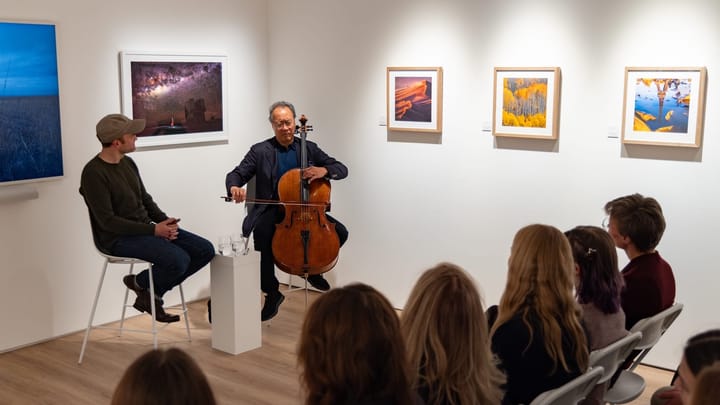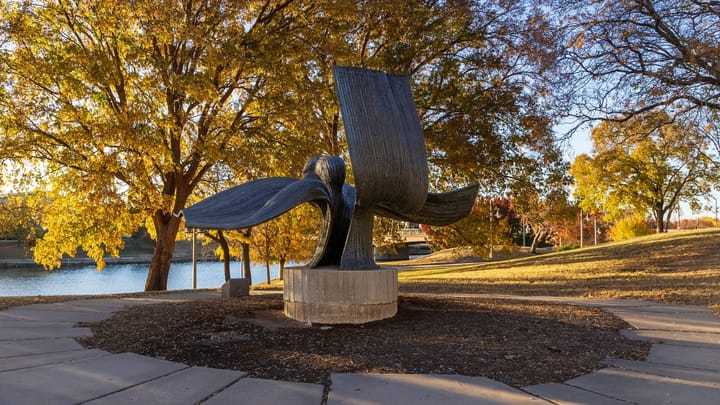Ceramics of the Central Plains: The 'Wichita Ceramics Regional Exhibition' at Reuben Saunders Gallery
The juried exhibition features functional and sculptural ceramic works by 38 artists from the Central Plains.
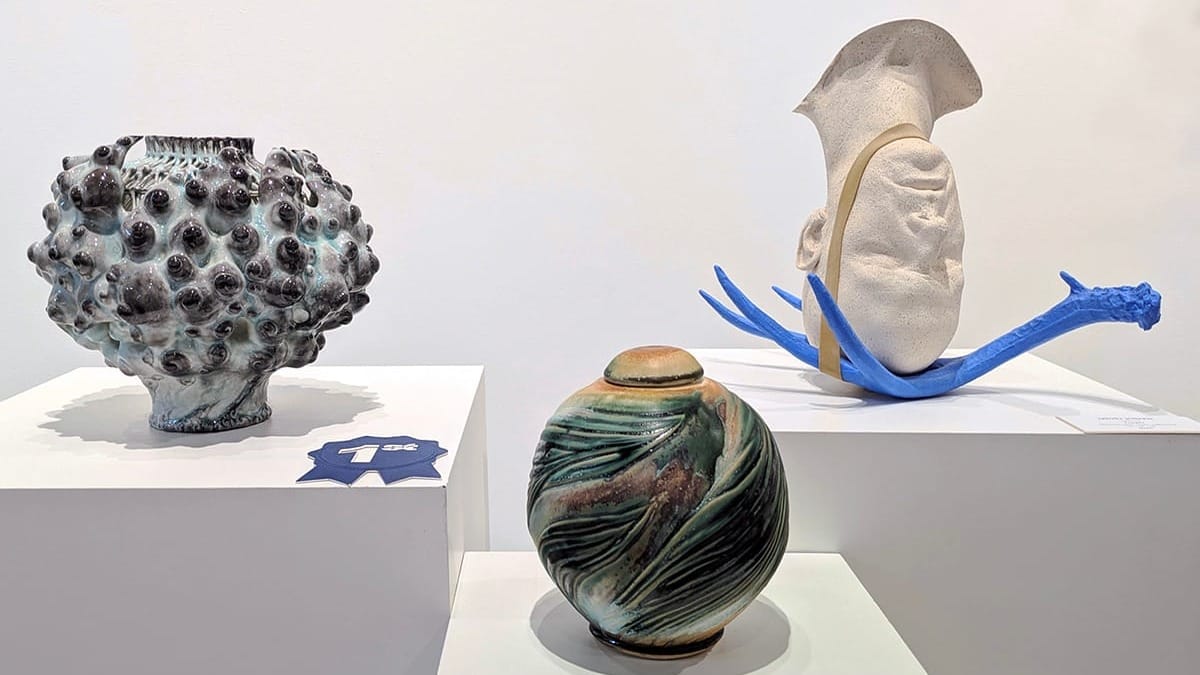
Wichita ceramic artist Brenda Lichman once opined in a lecture that your favorite coffee mug might be one of the most intimate relationships you have, and I think about that idea all the time. This is an object you hold in your hands and put to your mouth nearly every day. It warms you, it comforts you, it sustains you. Who or what and how often do you embrace someone or something else with your lips? And yet, the mug is an inanimate object, albeit a treasured one, that lives in a cabinet for most of the day.
Ceramics are often undervalued because they can be so utilitarian and thus overlooked. That is precisely what makes the medium so important in the “Wichita Ceramics Regional Exhibition: Pots with Purpose” at Reuben Saunders Gallery, 3215 E. Douglas Ave. in Wichita. Proceeds from the sales of the 46 works will benefit Empty Bowls Wichita, a local outpost of the international, artist-driven movement to “(fight) hunger through clay, community, and connections — one bowl at a time.” Lichman founded Empty Bowls Wichita in 2014.
Juried by Lawrence Arts Center interim director Ben Ahlvers, the pieces on display showcase the true artistry and craftsmanship of the Central Plains region. Yes, there are skillfully made vessels and tableware, and also statement sculptures, whimsical figures, and multimedia intertwined with ceramics. Subjectively, this exhibition represents the best of more than 250 entries from about 65 applicants.
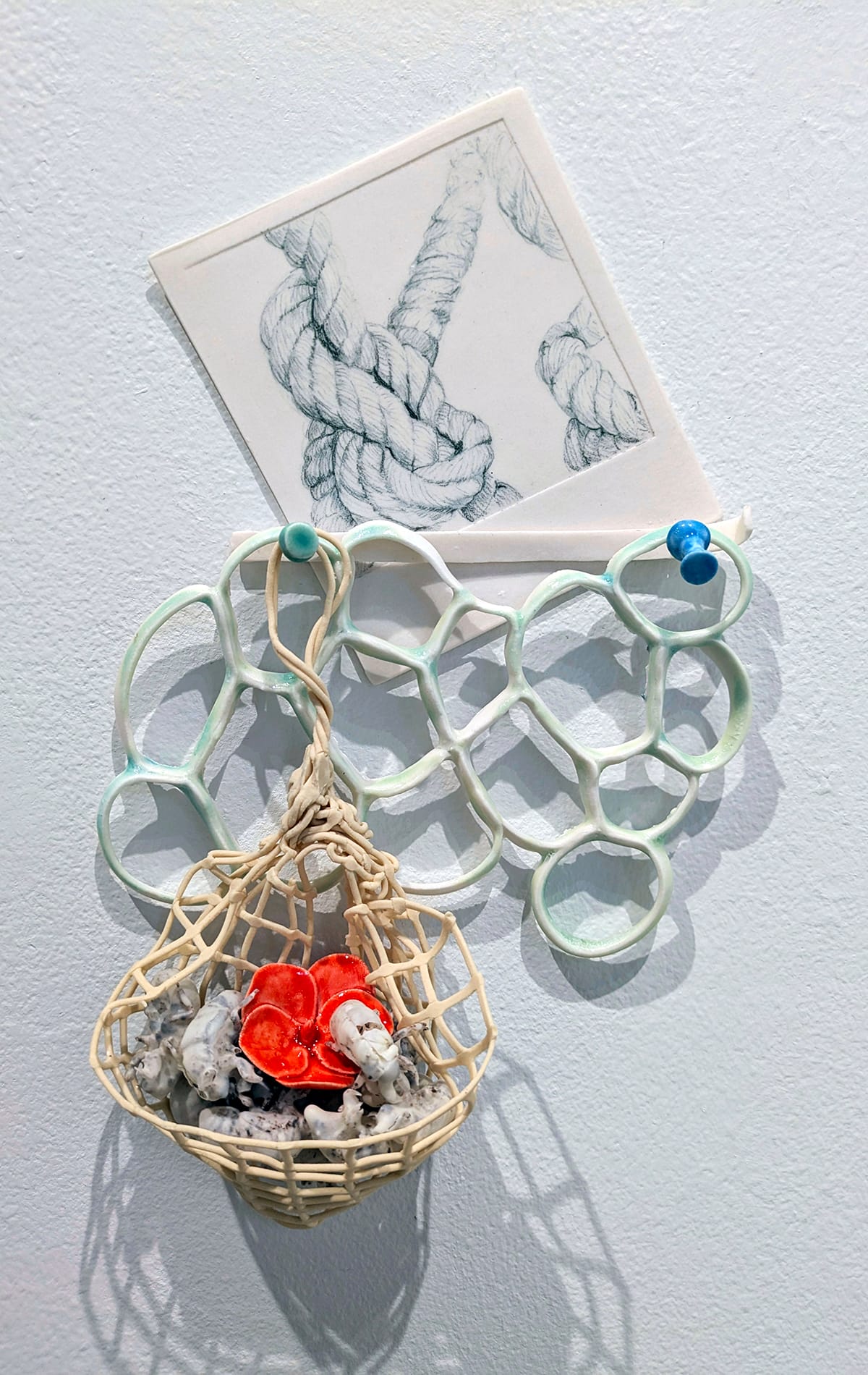
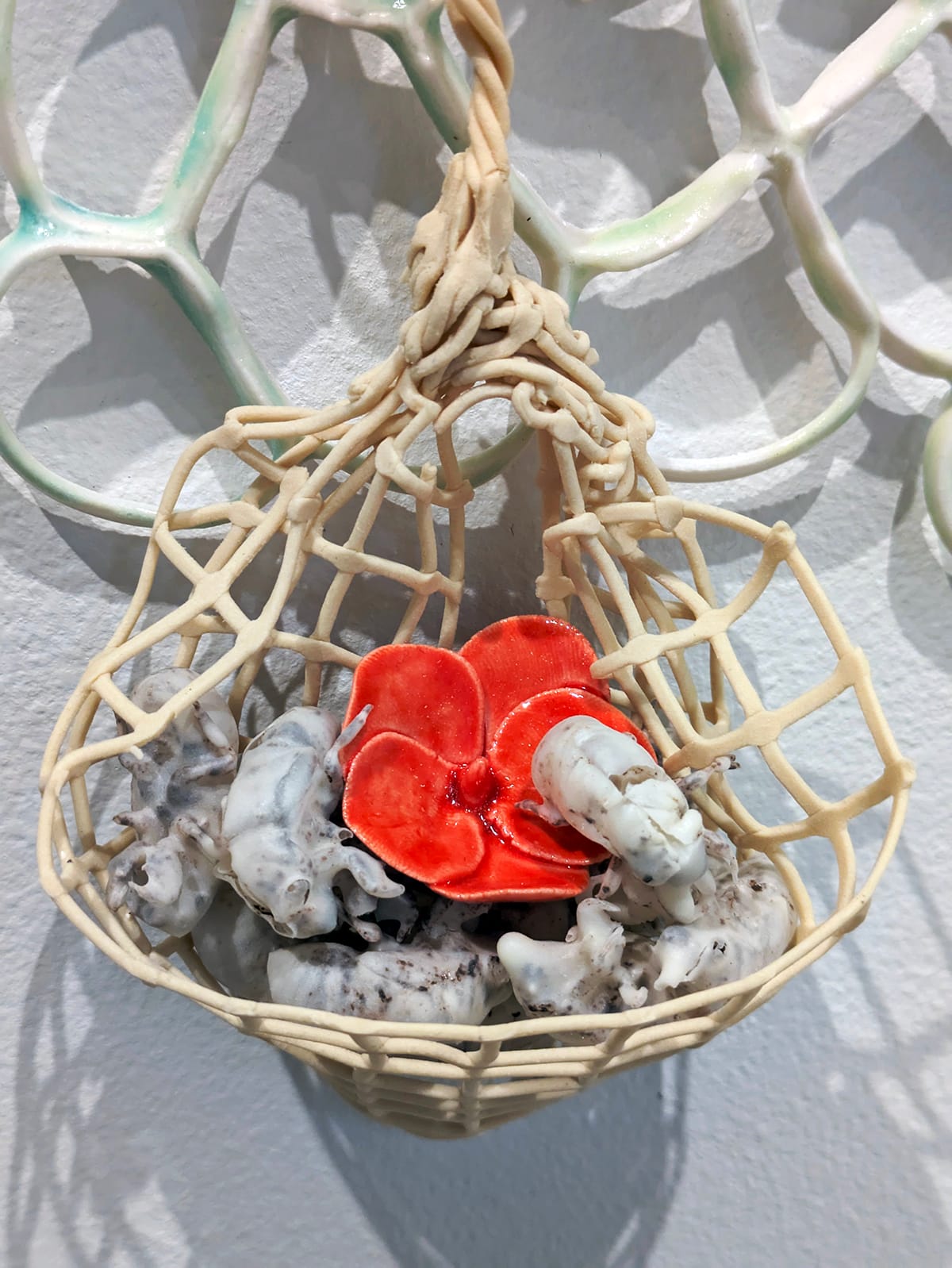
Trisha Coates, “Caught,” Cone 6 porcelain, 7 by 7 by 3 inches. Photos by Jessy Clonts Day for The SHOUT.
The first work I laid eyes on was my favorite, which I cast as my vote for the people’s choice award. “Caught” by Wichita artist Trisha Coates appears as a small net against a backdrop of ceramic water bubbles thumbtacked to a line on a wall, with a Polaroid photograph of a rope knot tucked behind it. Within the net is a singular orange flower and several castings of cicada exoskeleton molts. Upon a second, and third, closer look, I discovered that the entire work — the net, thumbtacks, and even the knotted rope “photograph” are all made of porcelain. My discovery felt like a prize for looking so closely at what could have easily been missed for its realism.
Exhibitions at Reuben Saunders Gallery are always visually interesting in the way the gallerists arrange and hang them. The large, main gallery space is a blank canvas of a room into which they use furniture and artfully positioned pedestals of varying heights to gently guide foot traffic through the show, while giving viewers nearly 360-degree access to the sculptural works. Smaller pieces are arrayed on wall shelving, and several works are displayed directly on the walls, giving visitors the opportunity to look high and low.
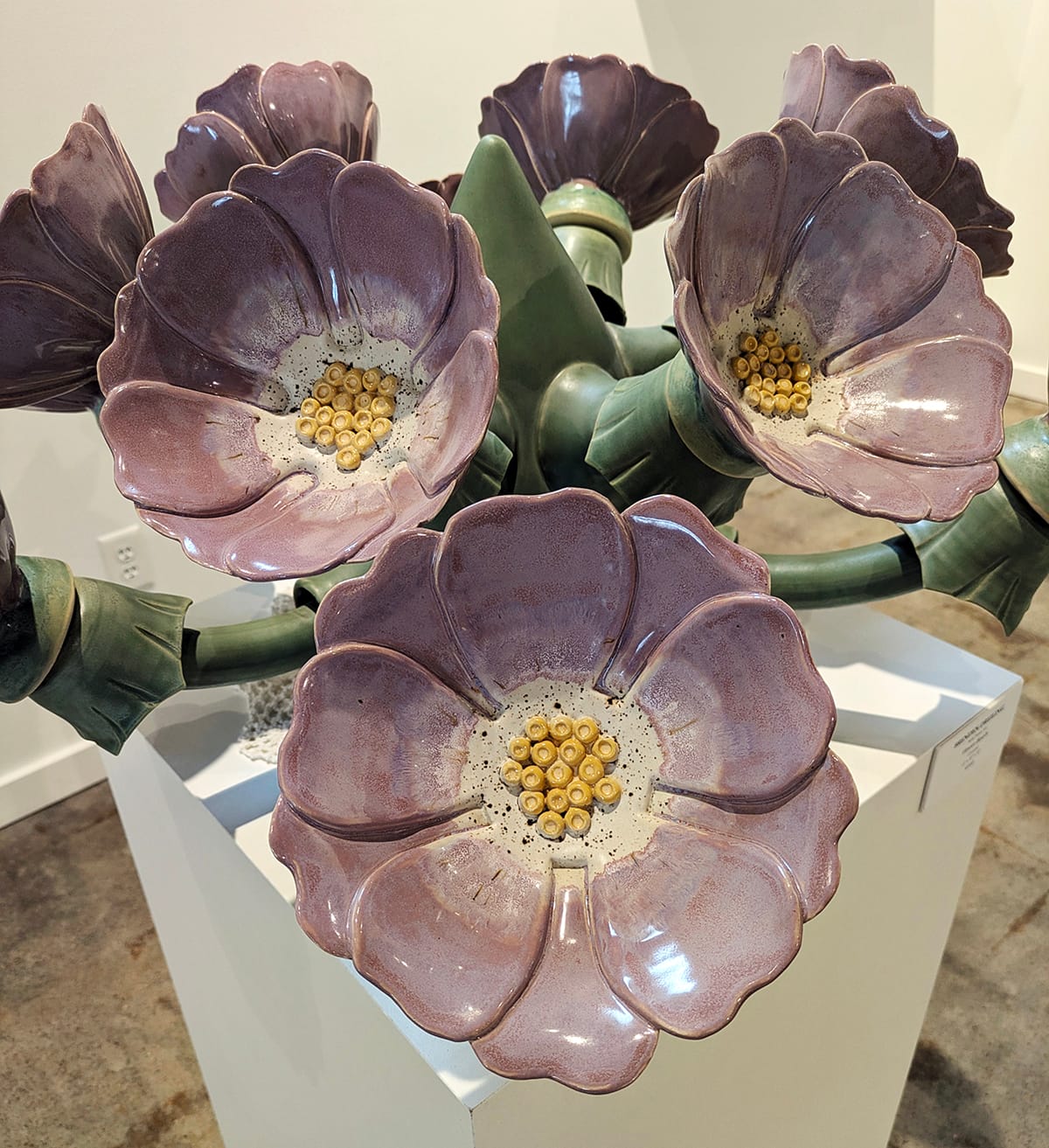
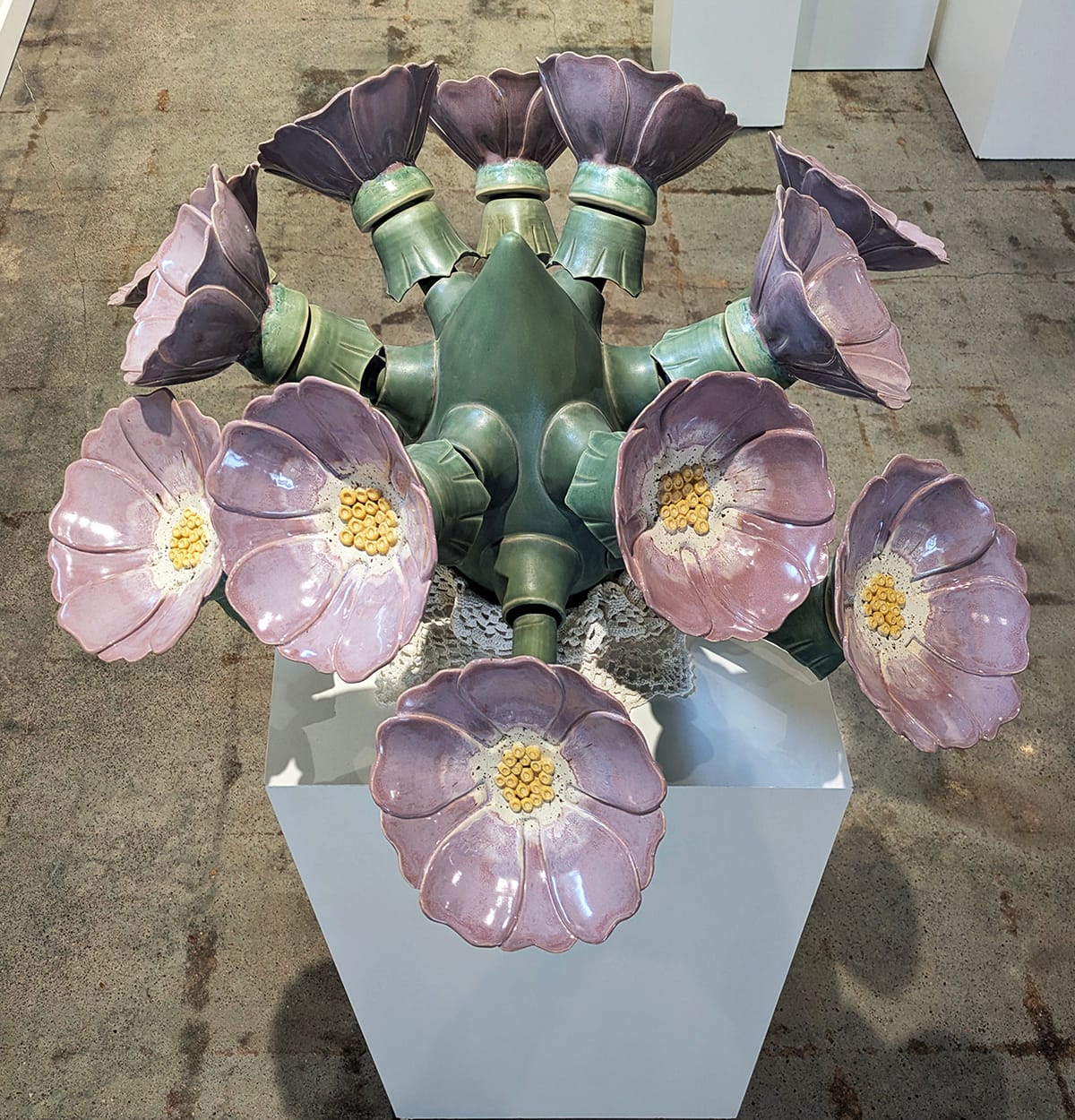
Brenden Dreiling, “Flower Bowls,” Ceramic, 13 by 32 by 32 inches. Photos by Jessy Clonts Day for The SHOUT.
In this show, the applied utility of many works are far from obvious. As playfully presented in “Flower Bowls” by Belle Plaine, Kansas artist Brenden Dreiling, within a large — nearly three feet wide — bouquet of purple flowers, each flower can be removed from its “stem” and function as a standalone bowl. A terracotta “Space Colander” by Peyton, Colorado artist Brenda Jones features in its center an astronaut cat in a spaceship surrounded by star-shaped holes. A coil-built jug in equine form, “Appaloosa Ewer” by Garland, Texas artist Amy Henson, receives water through the end of its tail and pours from its mouth.
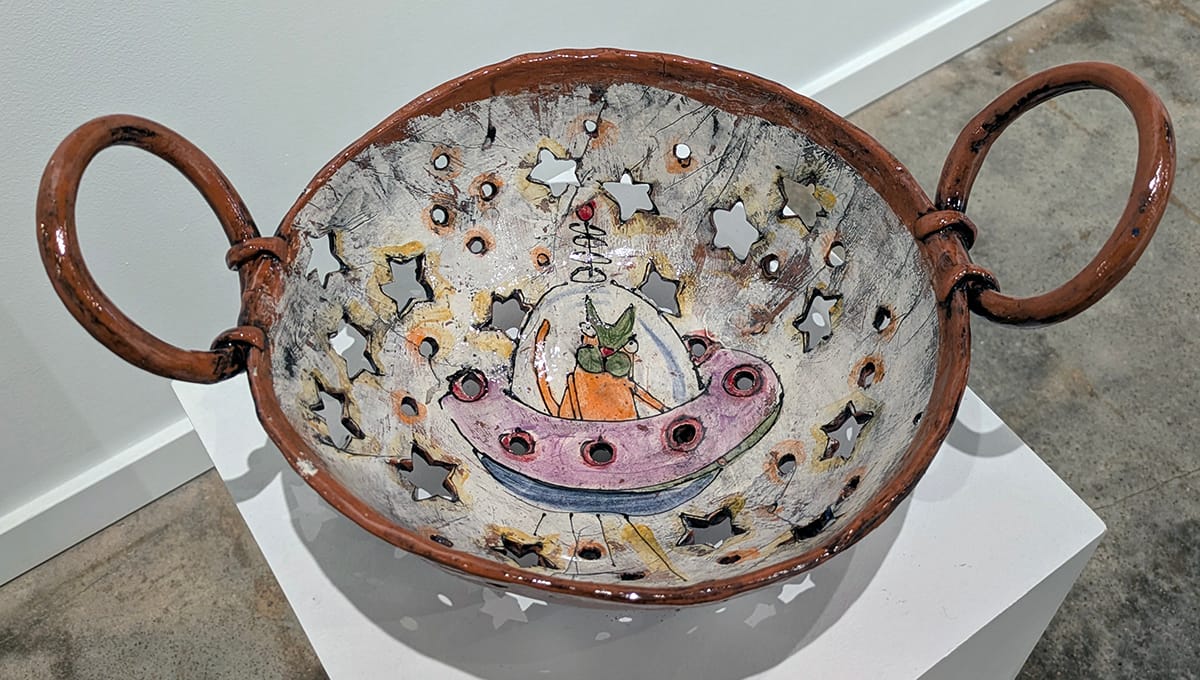
Brenda Jones, “Space Colander,” Terra cotta, underglaze, glaze, 8 by 12 by 12 inches. Photo by Jessy Clonts Day for The SHOUT.
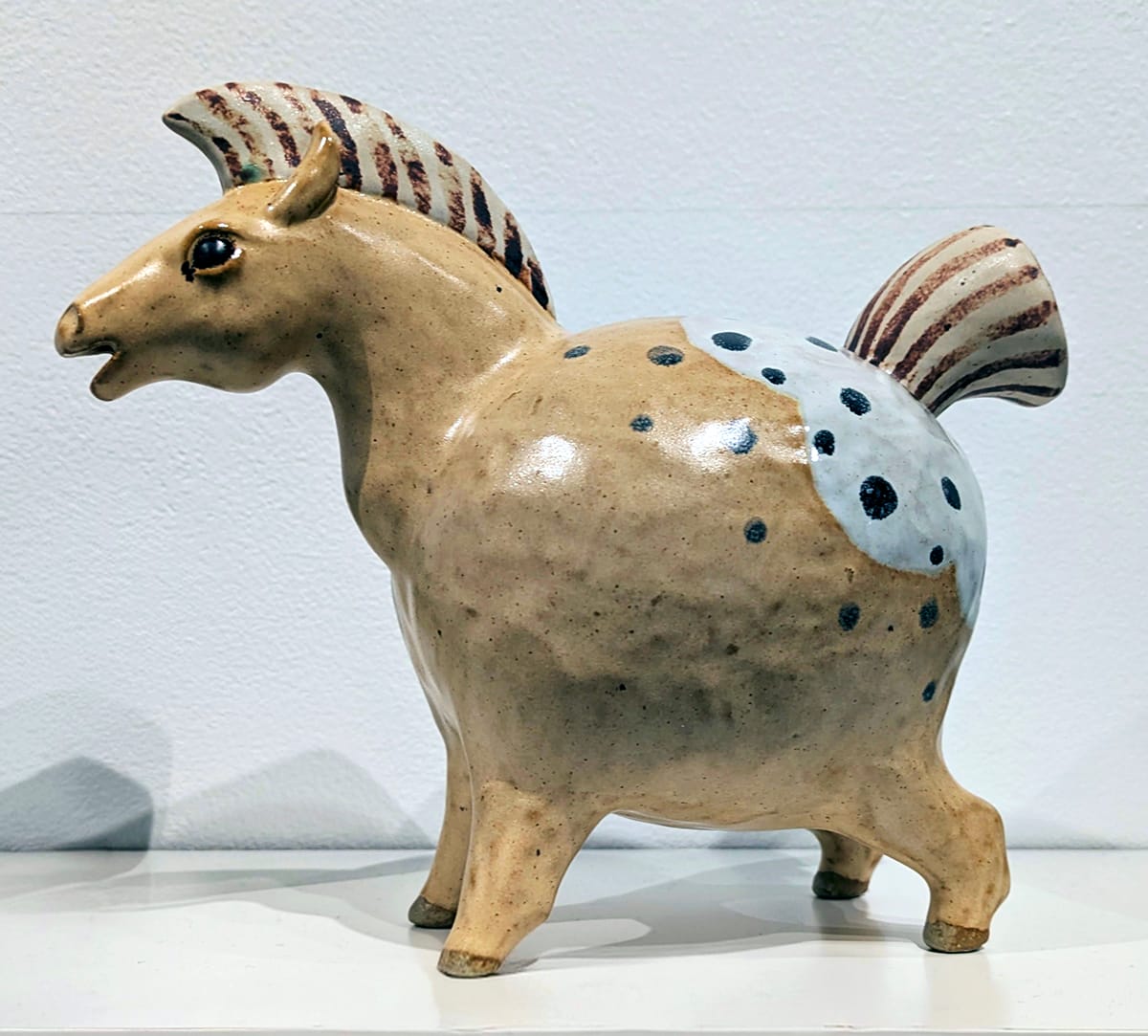
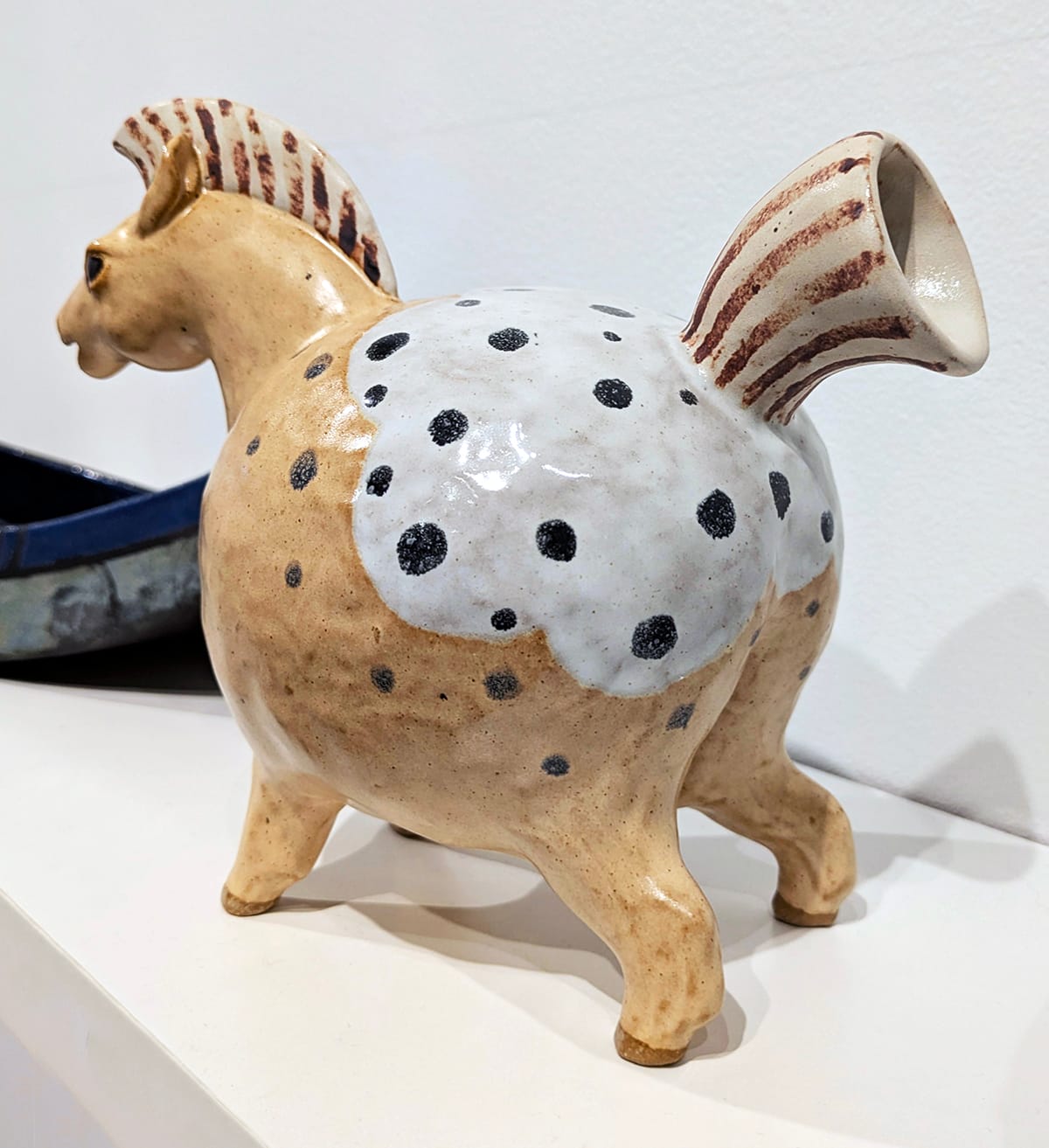
Amy Henson, “Appaloosa Ewer,” Coil-built cone 6 stoneware, glaze, 6.75 by 8.5 by 4.5 inches. Photos by Jessy Clonts Day for The SHOUT.
Intricate details that require much more than a glance abound throughout the exhibition. Somehow Benjie Heu of Jackson, Missouri, implied facial features that don’t actually exist using the shapes of other objects on his whimsical tattooed and apron-clad “Clay Dude” figure. A birdcage and a roll of dollar bills for eyes, a thistle for a nose, dandelion leaves for a jaw line, and dozens of other decals are overglazed onto “dude’s” pink, bear-shaped head. “Clay Dude” won an honorable mention.
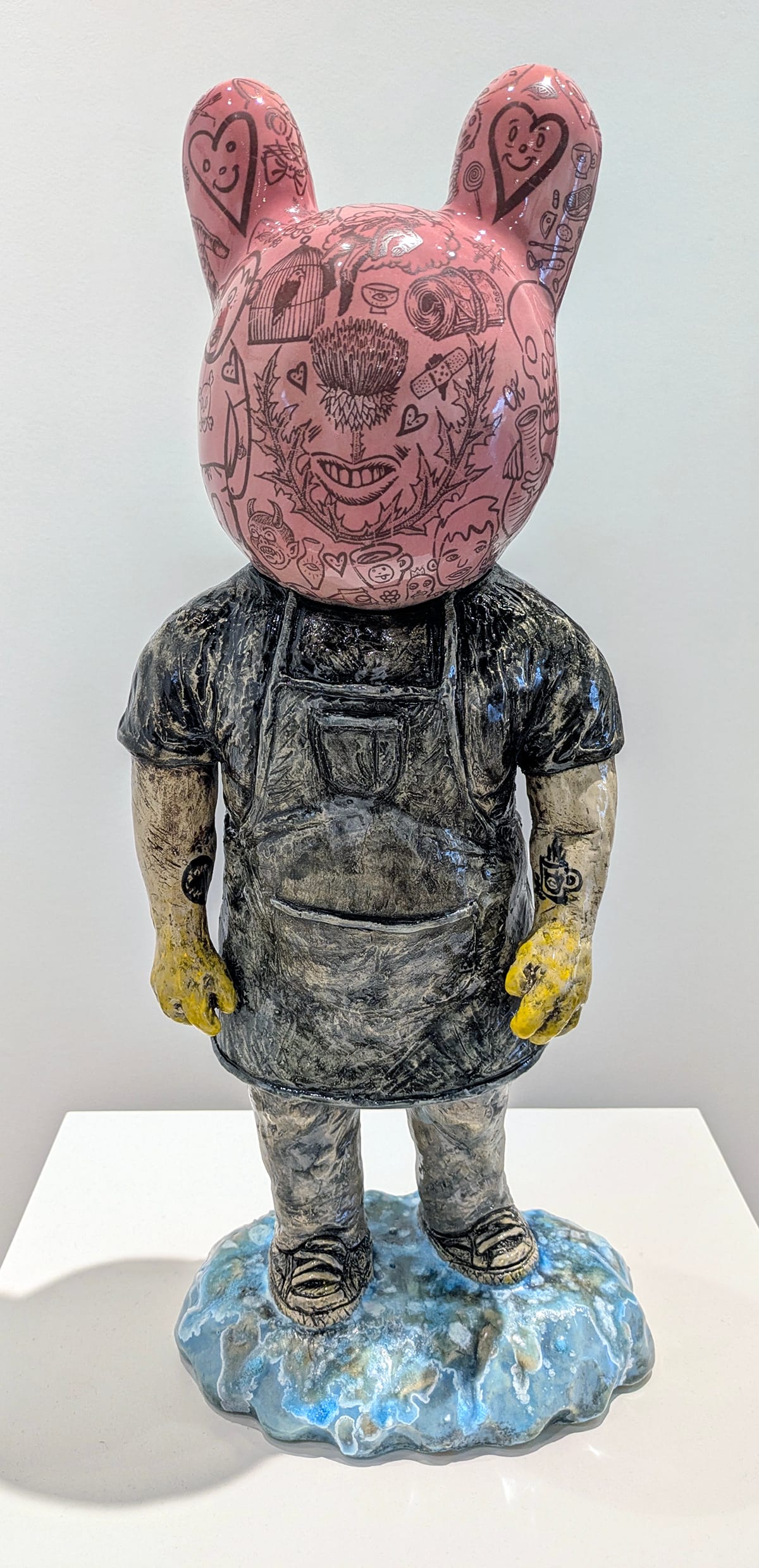
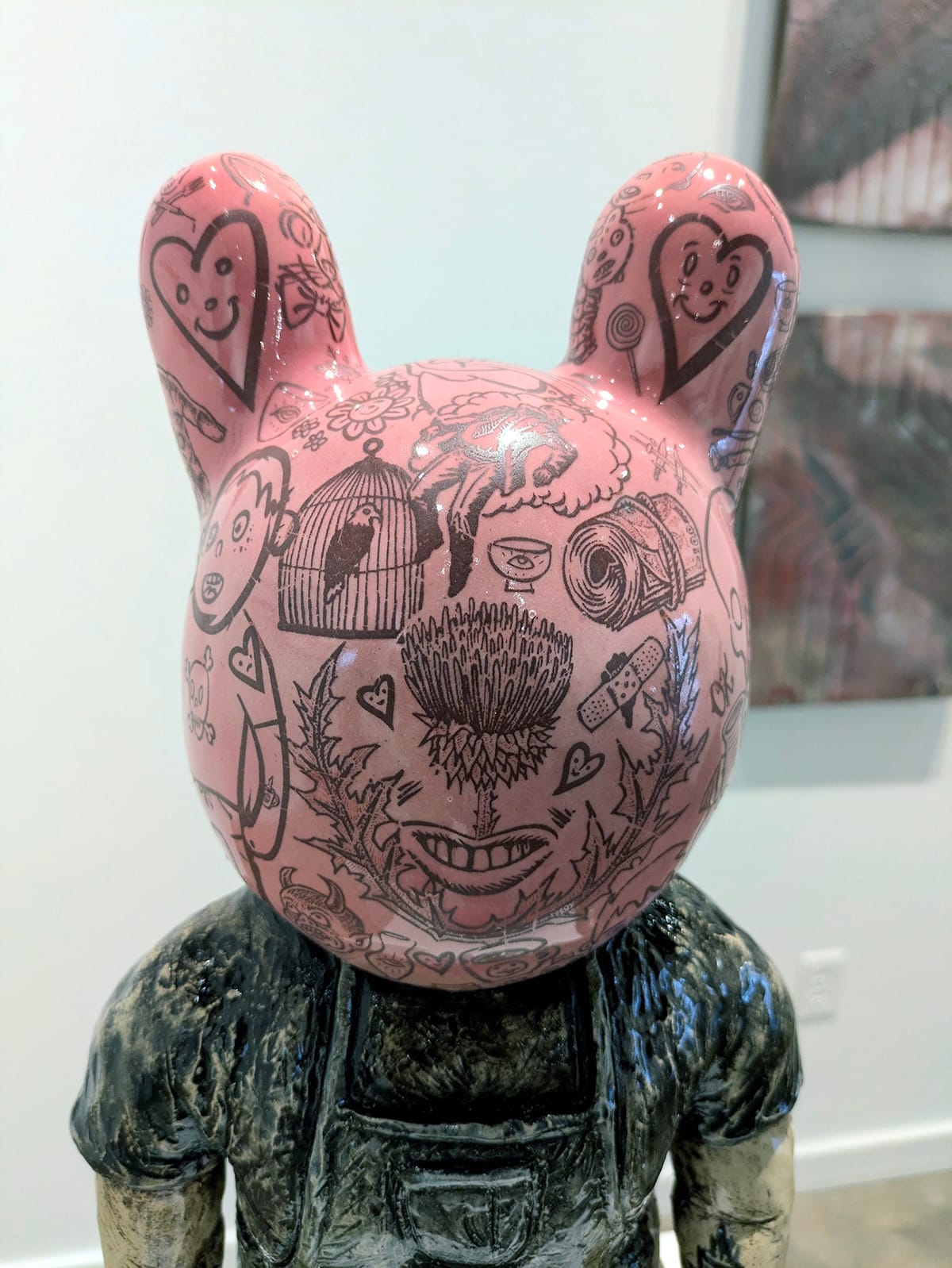
Benjie Heu, “Clay Dude,” Cone 6 clay, underglaze, glaze, glass, ceramic decals, 20.5 by 8.5 by 6 inches. Photos by Jessy Clonts Day for The SHOUT.
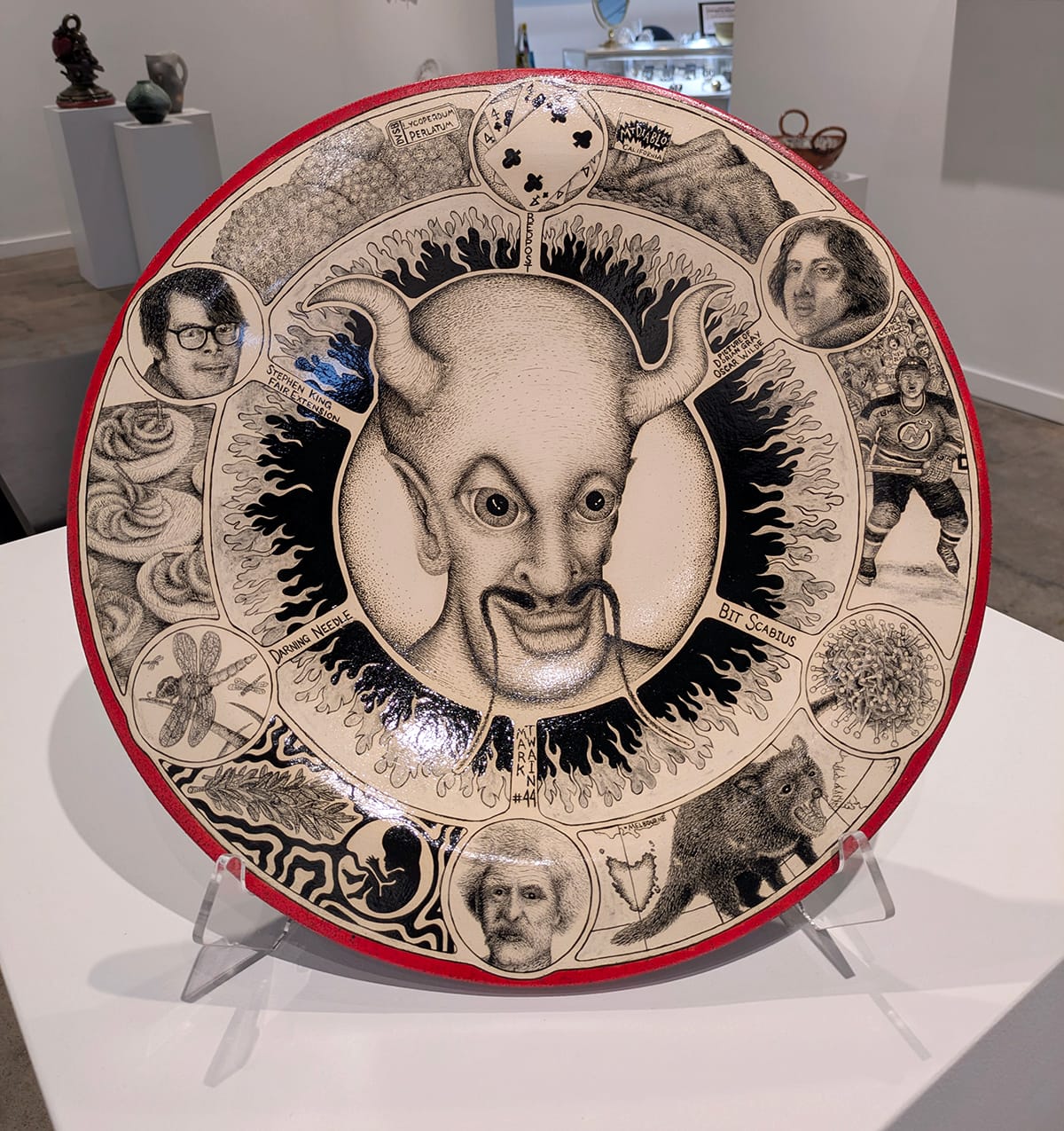
Stuart Asprey, “Giving the Devil His Due,” Ceramic, underglaze, colored slip, glaze, 21 by 21 by 5 inches. Photo by Jessy Clonts Day for The SHOUT.
“Giving the Devil His Due” by Stuart Asprey of Norman, Oklahoma, is a bit of a game for discovering different ways to actually give the devil, in the center of a large red-rimmed plate, his due in detailed black-and-white underglazing. The California landmark Mt. Diablo and deviled eggs are self-evident. The flowering plant labeled “Bit Scabius,” commonly known as “devil’s bit,” and a portrait of writer Oscar Wilde alongside its label, “Picture of Dorian Gray,” a story in which its titular character essentially sells his soul to the devil for eternal youth, required some quick research.
Several artists combine the clever inferences made by their titles with their works to evoke feelings around our present zeitgeist. “Better Dead than Red” and “Tale of Two Cities” are both taken from historical references — a 1950’s anti-communist slogan and a 1859 Charles Dickens novel, respectively — but make statements that feel very pressing and contemporary. A wood-fired stoneware pile of partial human skulls, pierced by giant screws and placed around a red balloon in “Better Dead Than Red” by Von Vanhuizen of Lubbock, Texas, elicits a sense of futility toward humanity. Wood firing, by nature, can be unpredictable and outcomes are difficult to control. The natural ash glazing from the fire and smoke gives the work an overall dark coating and an existentially unmistakable aura of despair.
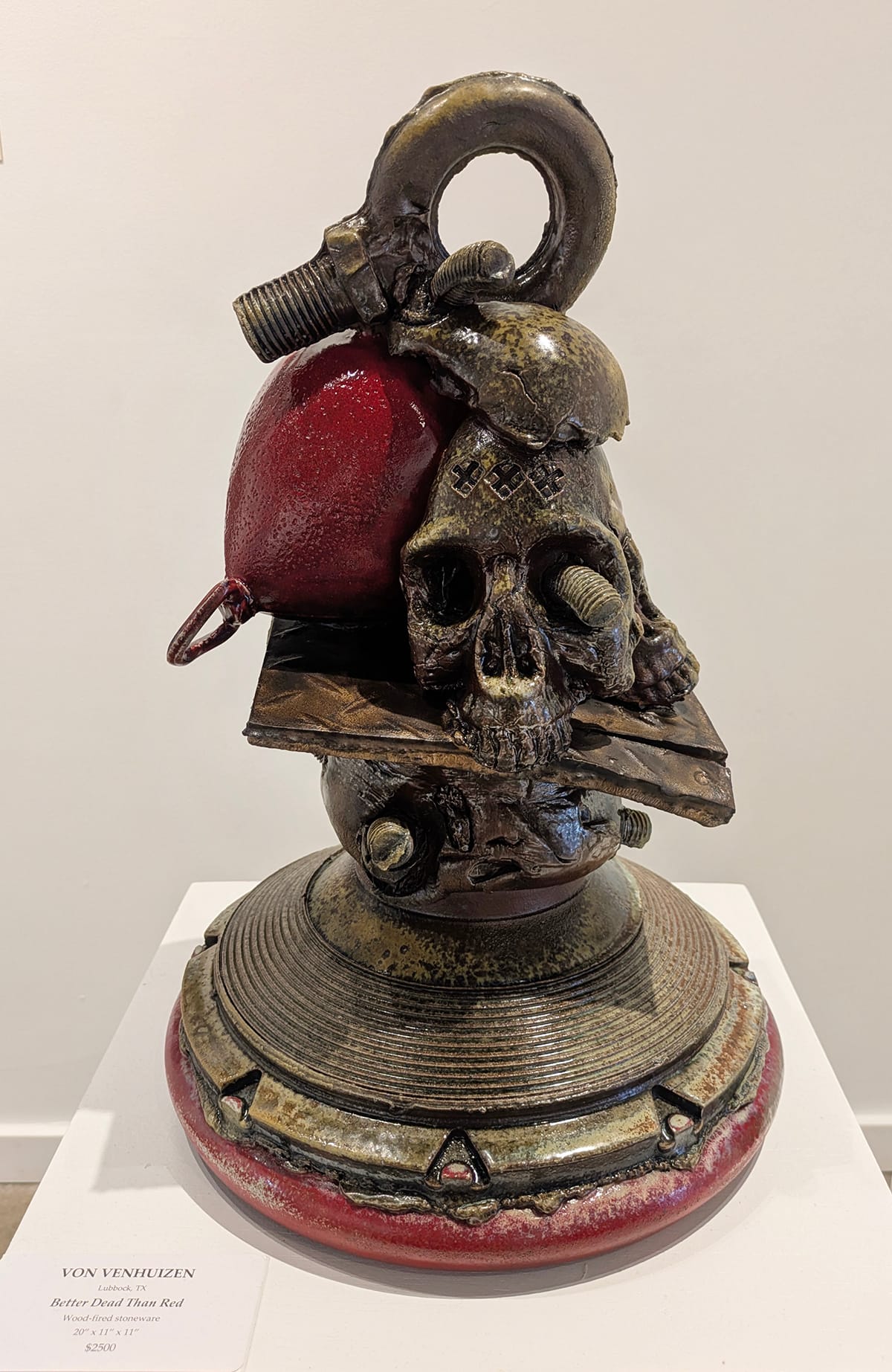
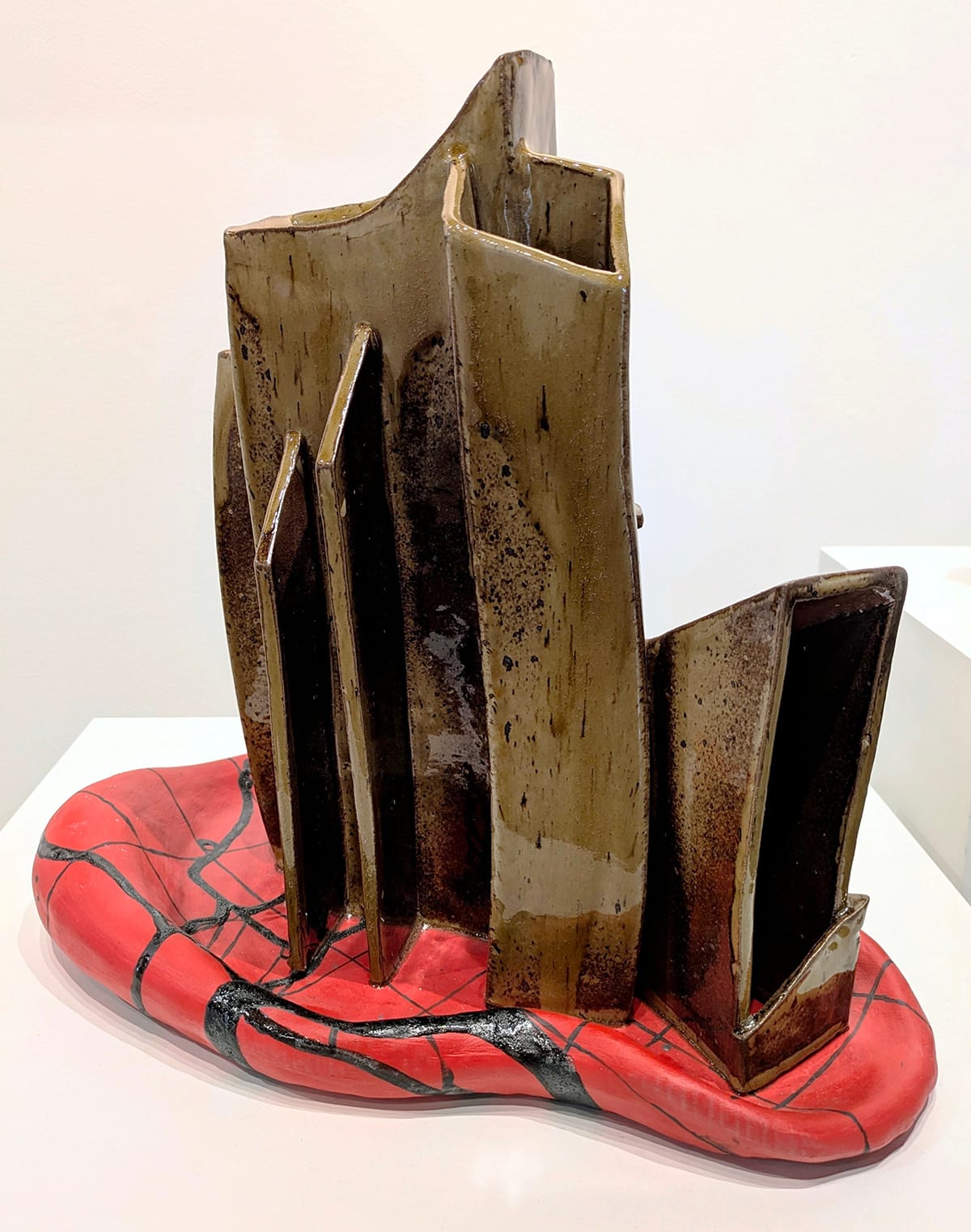
In “Tale of Two Cities” by Tulsa, Oklahoma artist Ben Bernard, a cluster of towering structures stands amidst a puddle of red. Clean black lines grid the puddle while more liquid black lines spill over the grid. Like the Dickens novel, which explores class struggle and wealth disparity, this sculpture quite literally shows what the sleek lines of industry can look like built on a foundation of landscape that was originally destined for other things before its destruction.
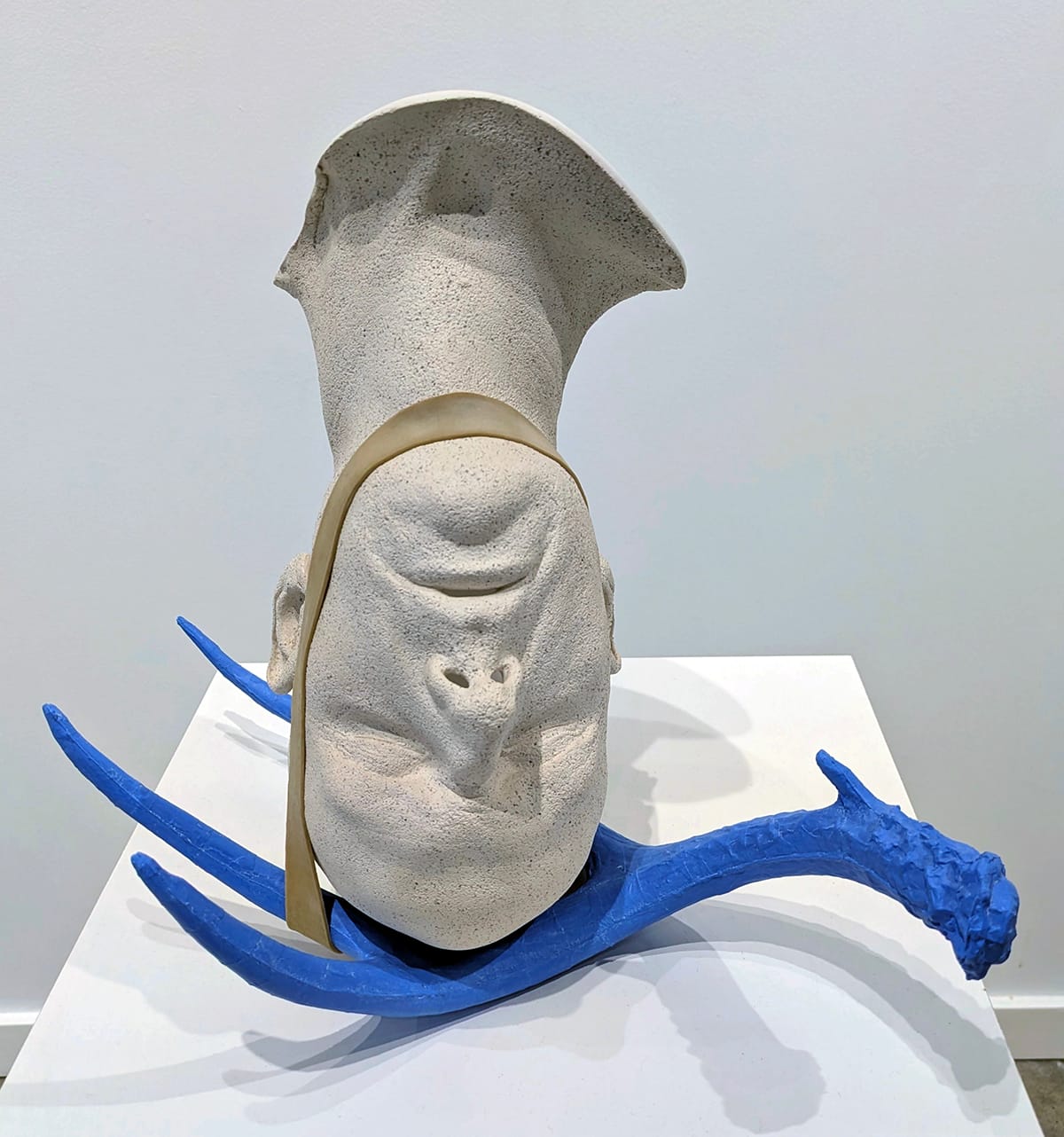
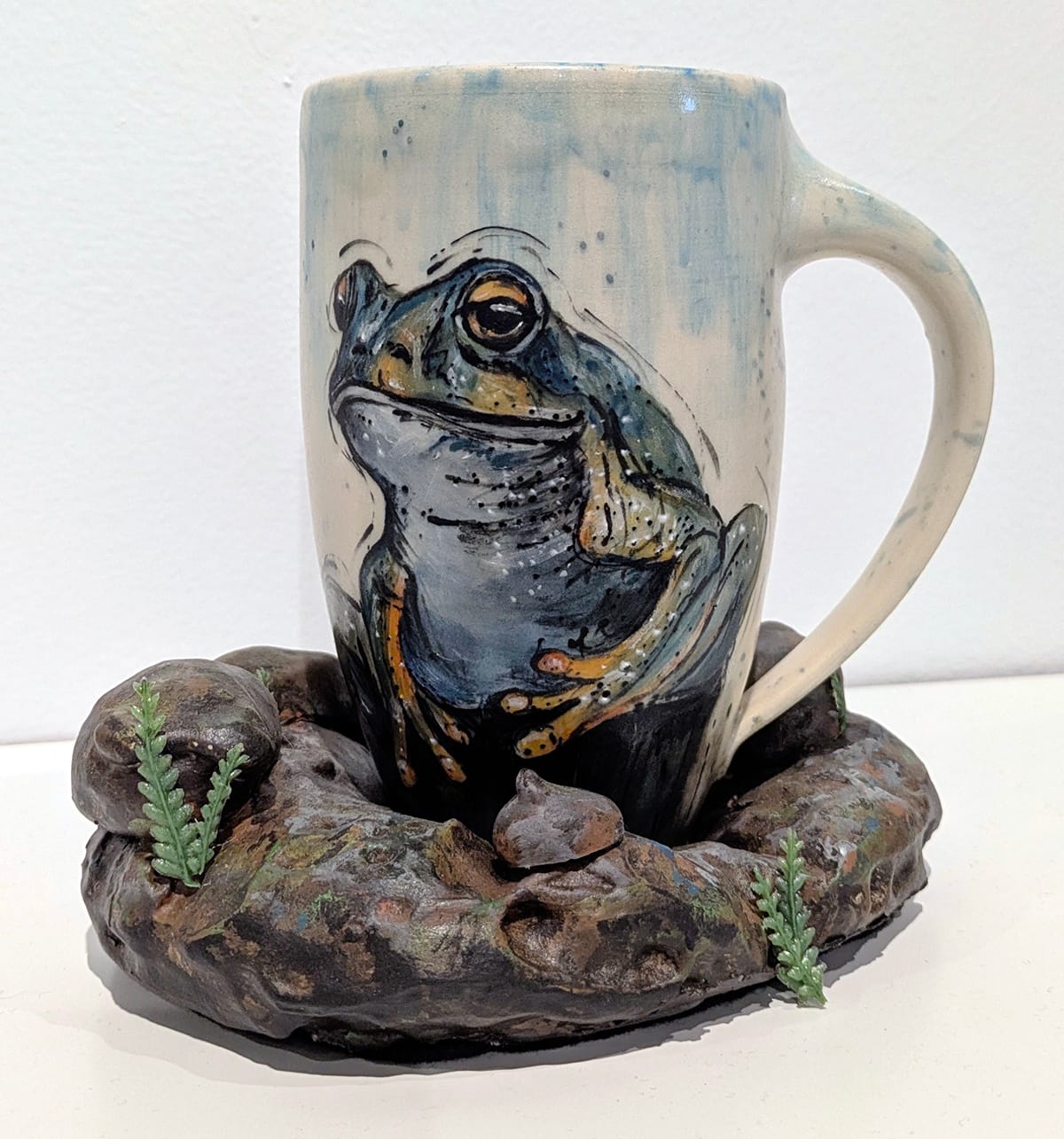
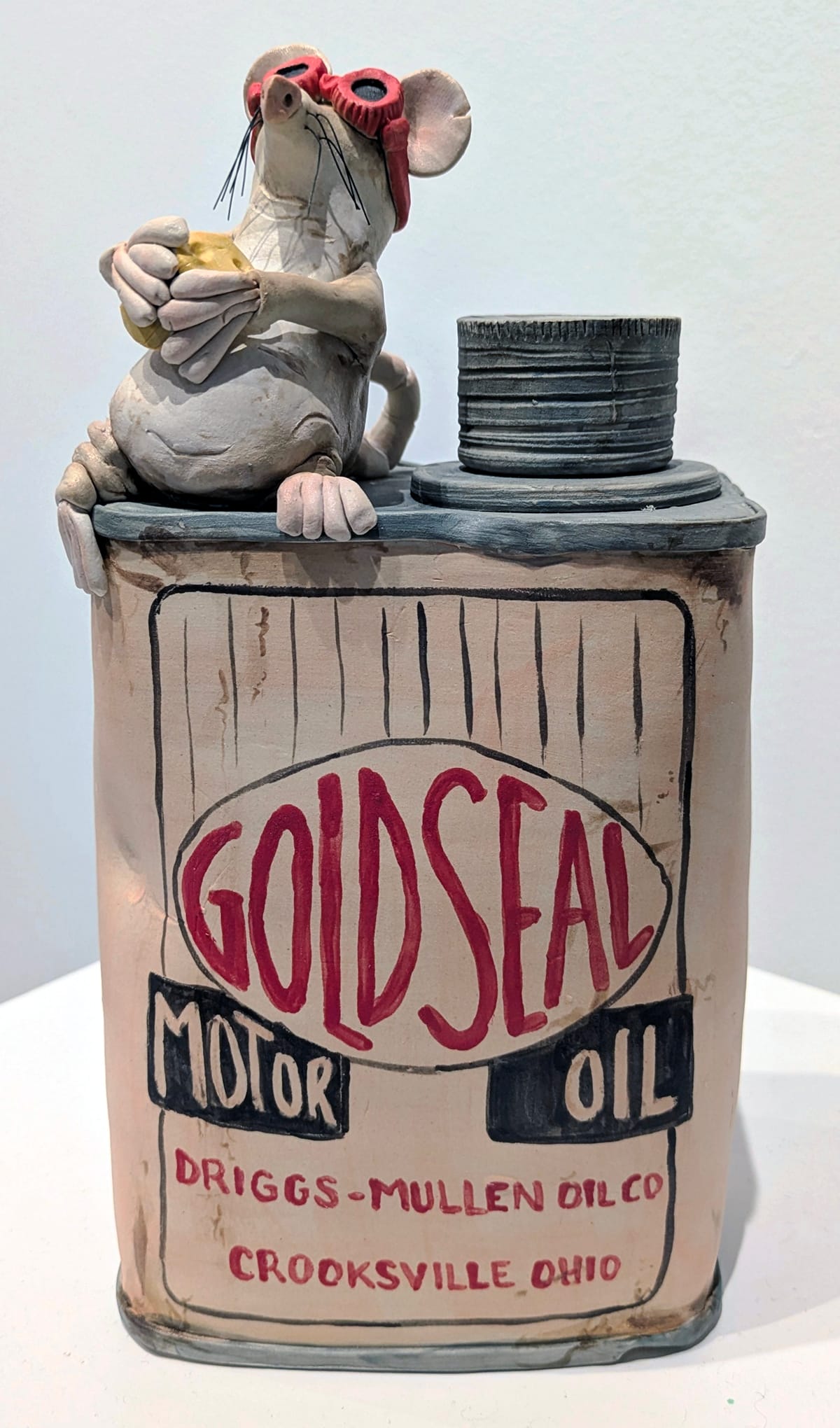
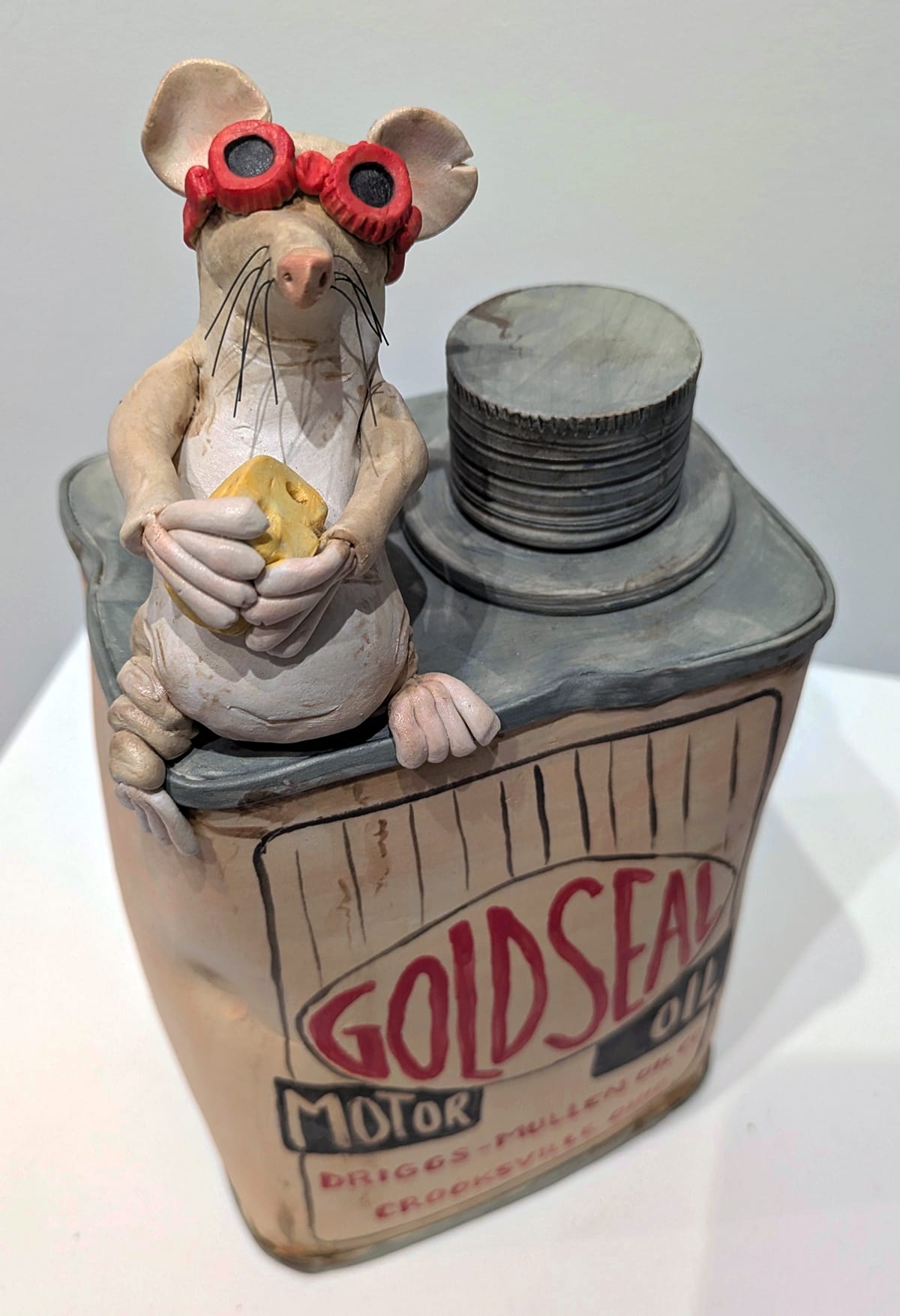
Angel Brame, “Chipowski,” Cone 6 stoneware, underglaze, 9 by 4.5 by 3 inches. Photos by Jessy Clonts Day for The SHOUT.
Numerous works are positively a visual romp. An upside-down, cast human head perches on blue antlers secured by a large rubber band chin strap in “Toupée,” by Qwist Joseph of Lincoln, Nebraska; a frog mug nests in its own unique, muddy bog holder embedded with plastic bits of fern in “Hippity Hoppity” by Bambi Freeman of Ellinwood, Kansas; a mouse in goggles holding a piece of cheese sits atop an antique can of motor oil in “Chipowski” by Angel Bram of Joplin, Missouri; a single cinderblock appears veiled in textural blue lace in “Cinder (Turquoise Lace)” by Betsy Alwin, of Snowmass Village, Colorado; and the porcelain face of a tiger peers through a swirl of white clouds in “Idle Thoughts 1” by Tyler Quintin of Prairie Village, Kansas. These delights display an imaginative take on the ceramics medium that, for a layperson who is relatively new to ceramics appreciation like myself, are an absolute blast to view.
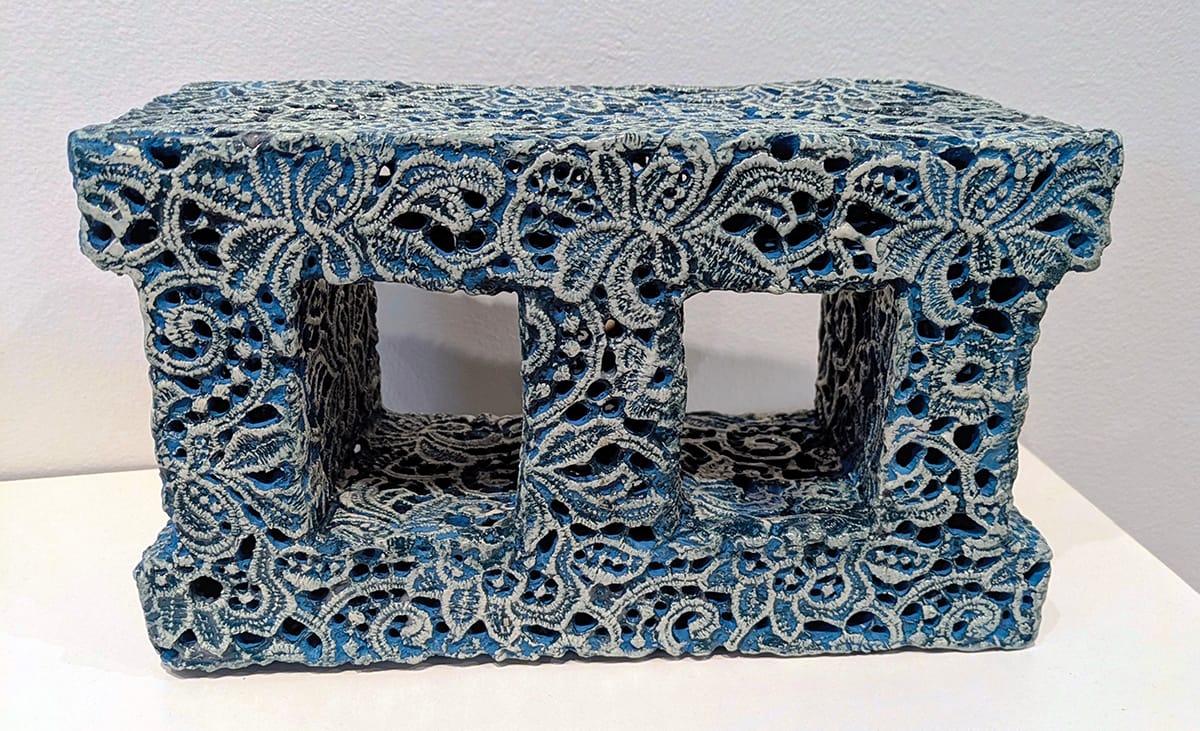
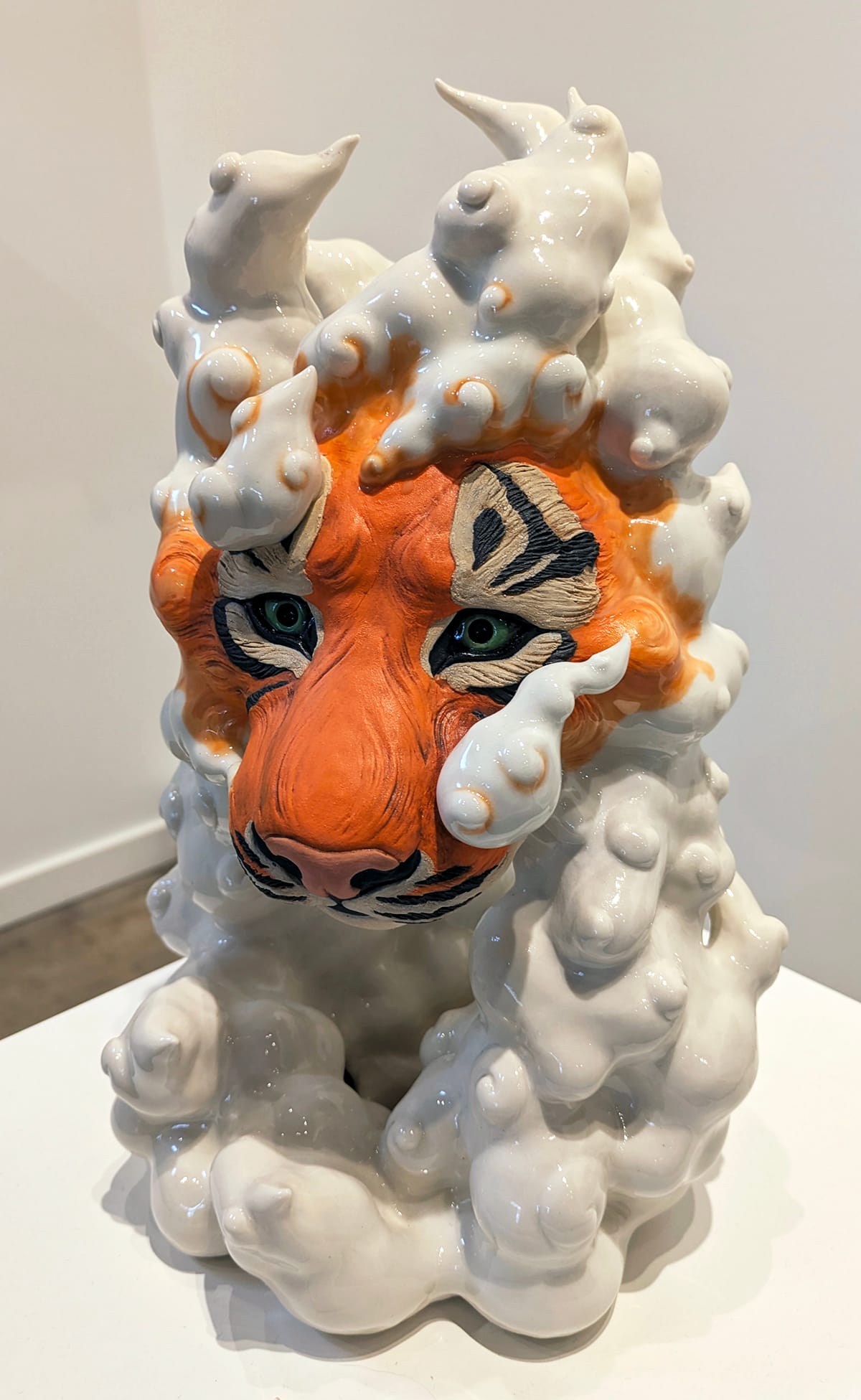
Yet, for all of the exhibition’s color, statement, and whimsy, it is sheer technique, form, and function that win out in the end for this juried show. Winning third place was a dark gray glazed porcelain “Stained Glass Teapot,” by Andrew McIntyre of Waco, Texas, dotted in blue crackled glaze that settles into circular indentation patterns. Second place was awarded to Emily Chamberlain of Wichita for her “Flower Brick,” a textured vase of cheerful cantaloupe, orange, yellow, and marigold colored glazes with holes in flower forms applied around the top of its base for additional flower stems.
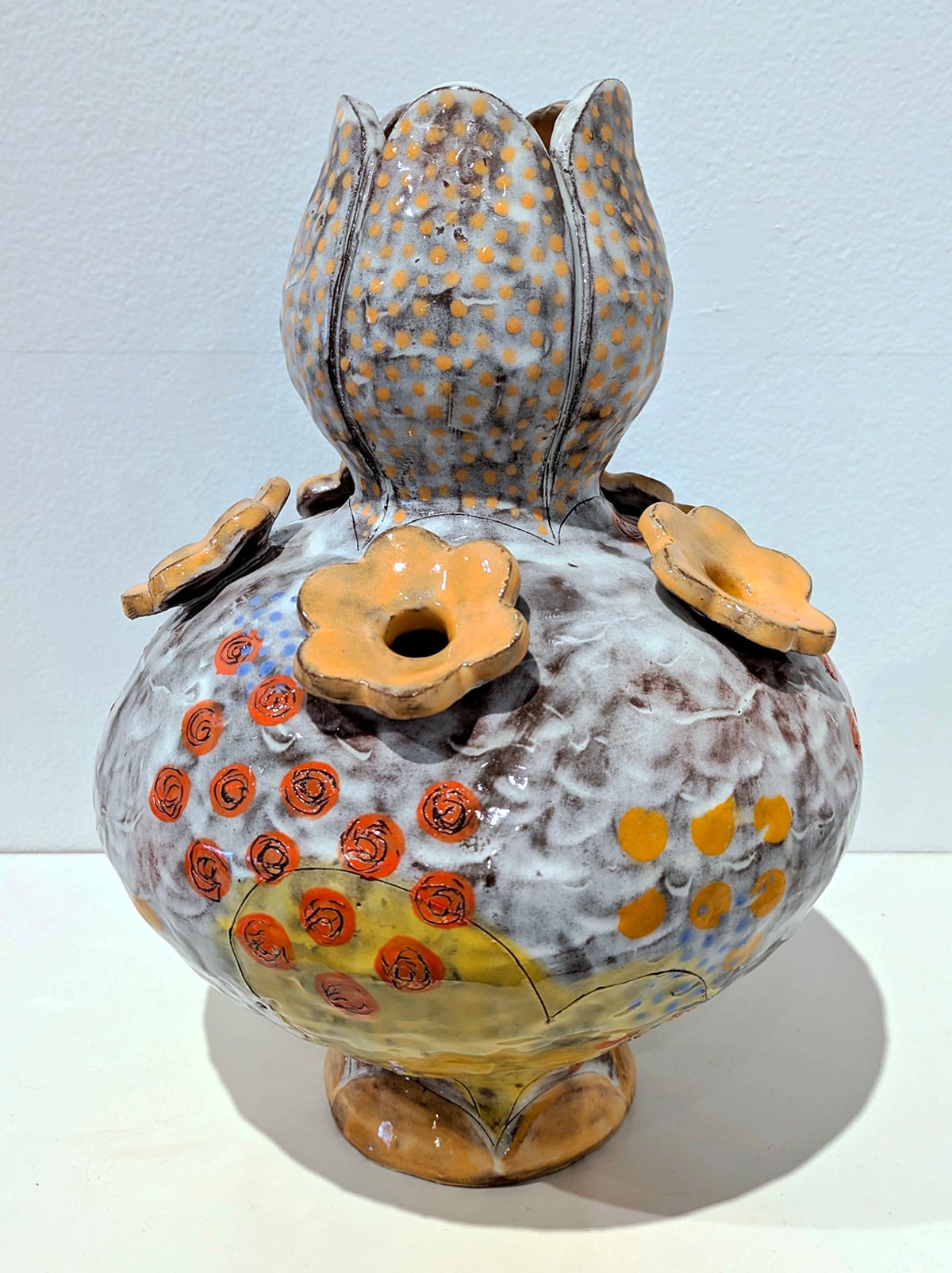
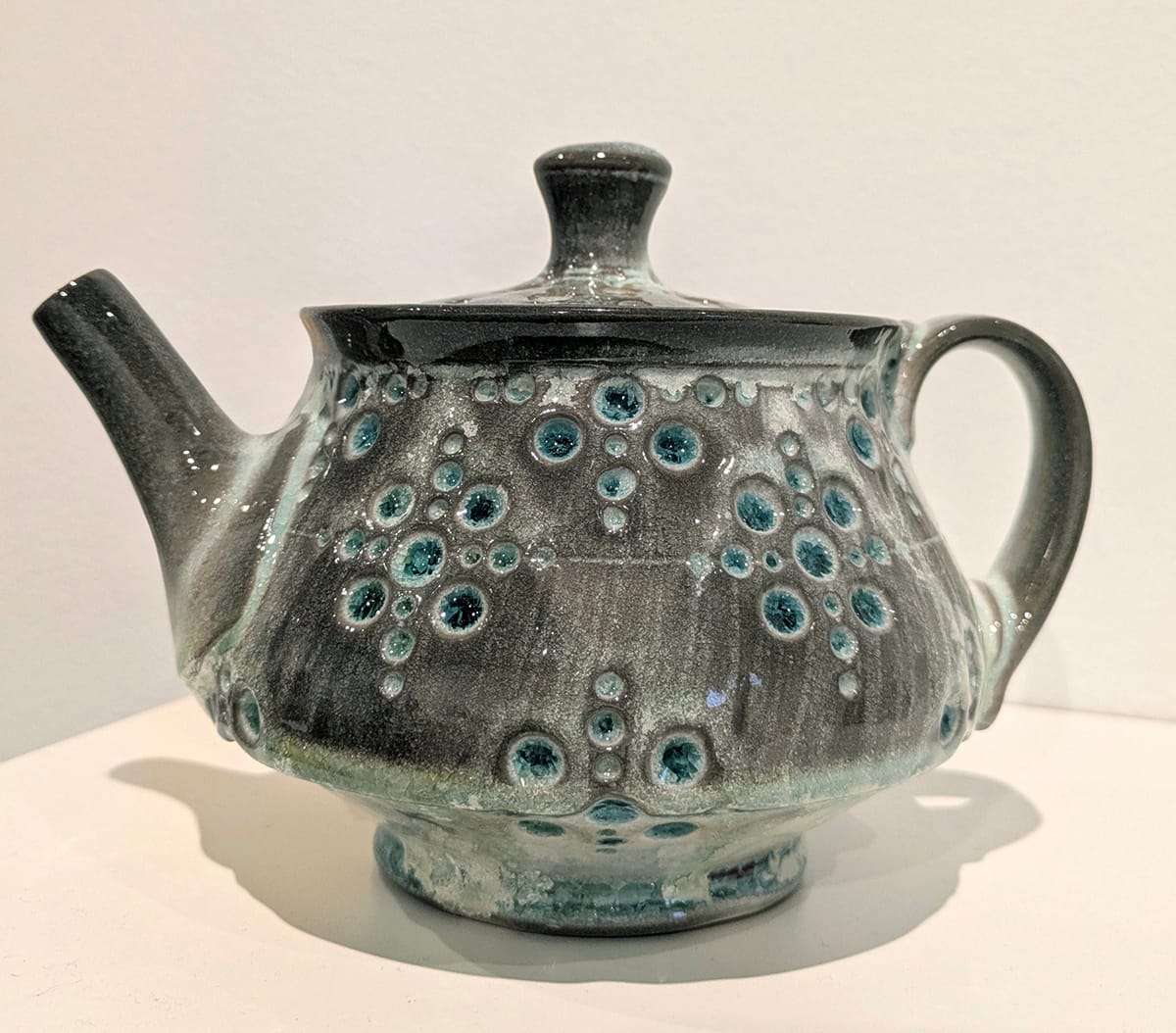
In first place is an intricately woven, soda-fired porcelain vase by Tyler Quintin of Prairie Village, Kansas, titled “Rendering Moon Jar.” Swirls of icy, bluish-gray cloud forms imply the distinctive globular shape of a traditional Korean moon jar, but the clouds surround and nearly envelope a second delicate, double-latticed inner jar. I know almost nothing of the techniques of working with porcelain, but anyone can imagine the amount of time and patience that must have gone into creating this exquisite work.
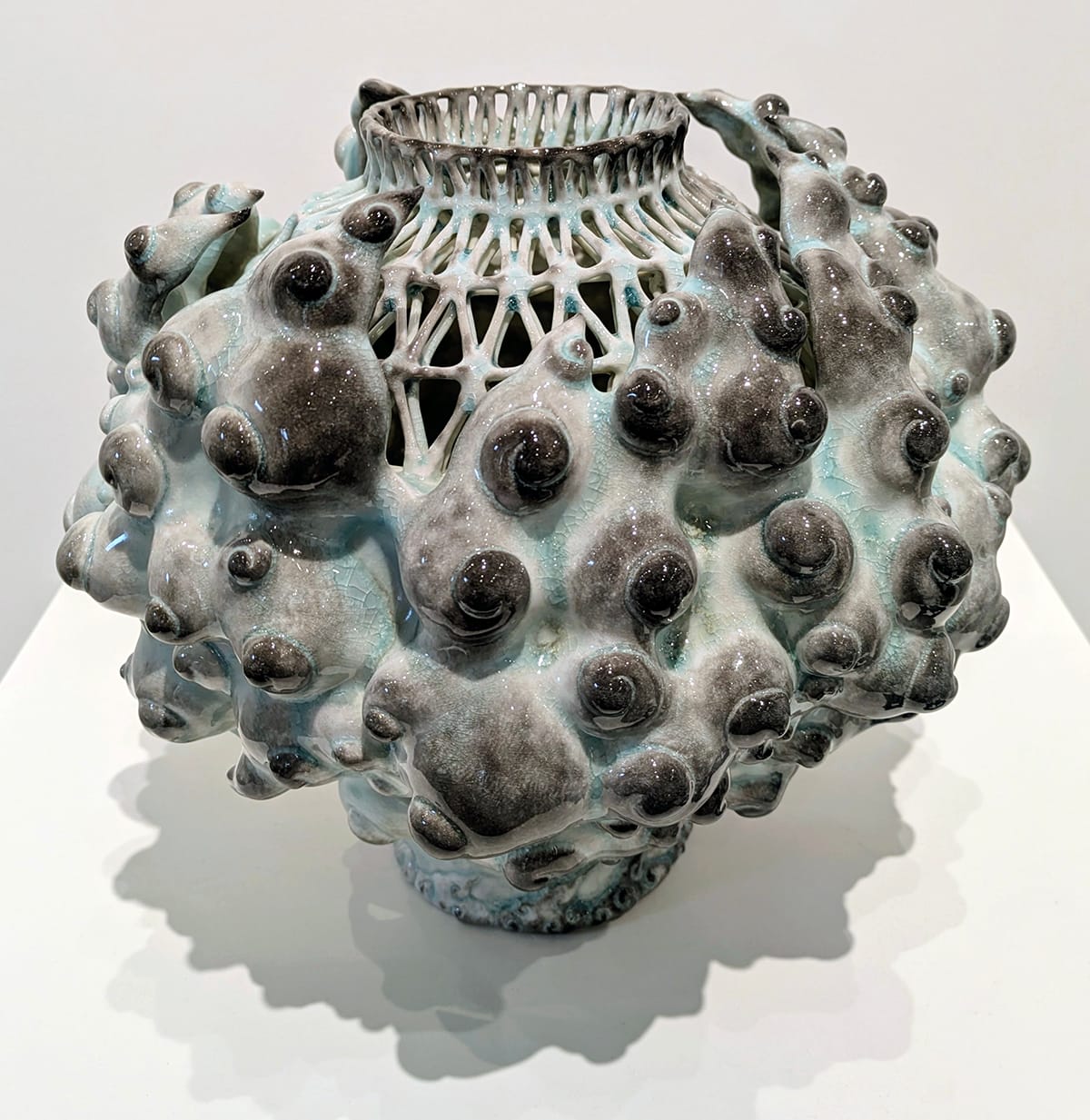
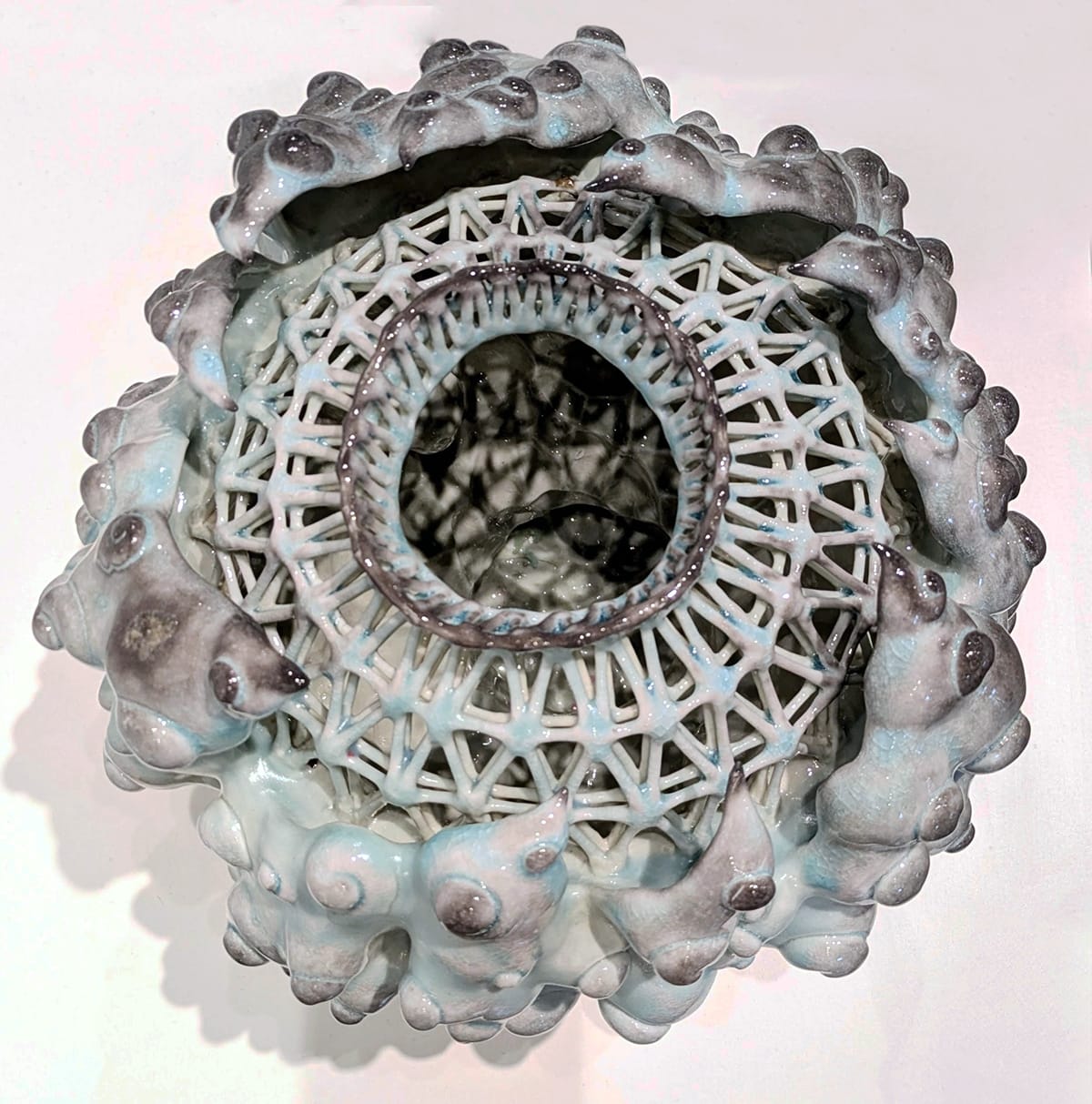
Tyler Quintin, “Rendering Moon Jar,” Soda-fired porcelain, glaze, 10 by 11 by 11 inches. Photos by Jessy Clonts Day for The SHOUT.
I visited this exhibition twice in the same week, and plan to visit once more before the month is out, as I know I am bound to discover something I didn’t notice before. Do not overlook this substantial representation of our region’s talent, and remember to vote for the people’s choice award.
The Details
“Wichita Ceramics Regional Exhibition: Pots with Purpose”
October 3-November 1, 2025, at Reuben Saunders Gallery, 3215 E. Douglas Ave. in Wichita
The gallery is open to the public from 10 a.m. to 5:30 p.m. Tuesday through Friday and 10 a.m. to 4 p.m. Saturdays. Voting for the people’s choice award continues through November 1.
Proceeds from this exhibition will be donated to Empty Bowls Wichita to fight food insecurity in the Wichita community.
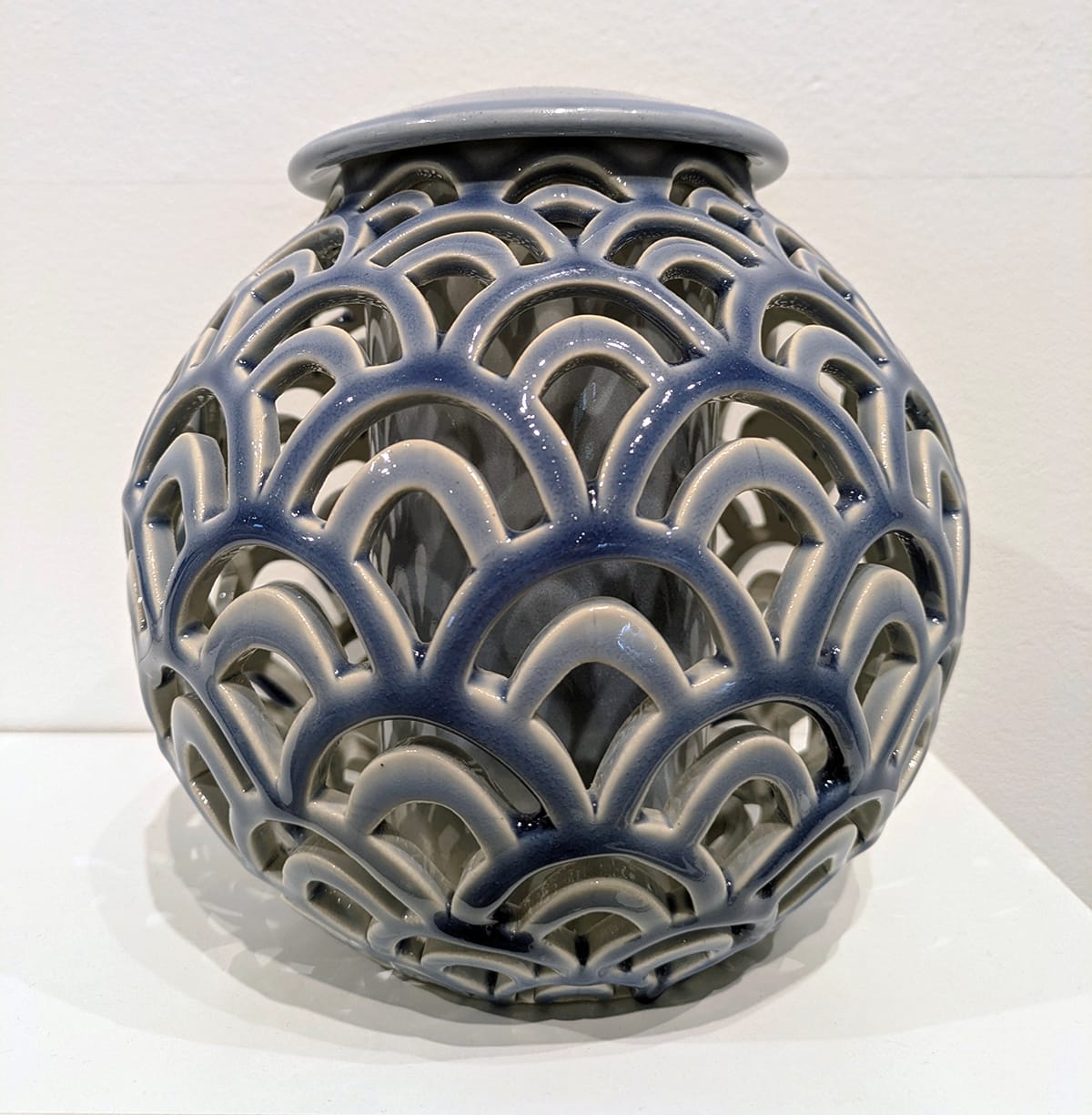
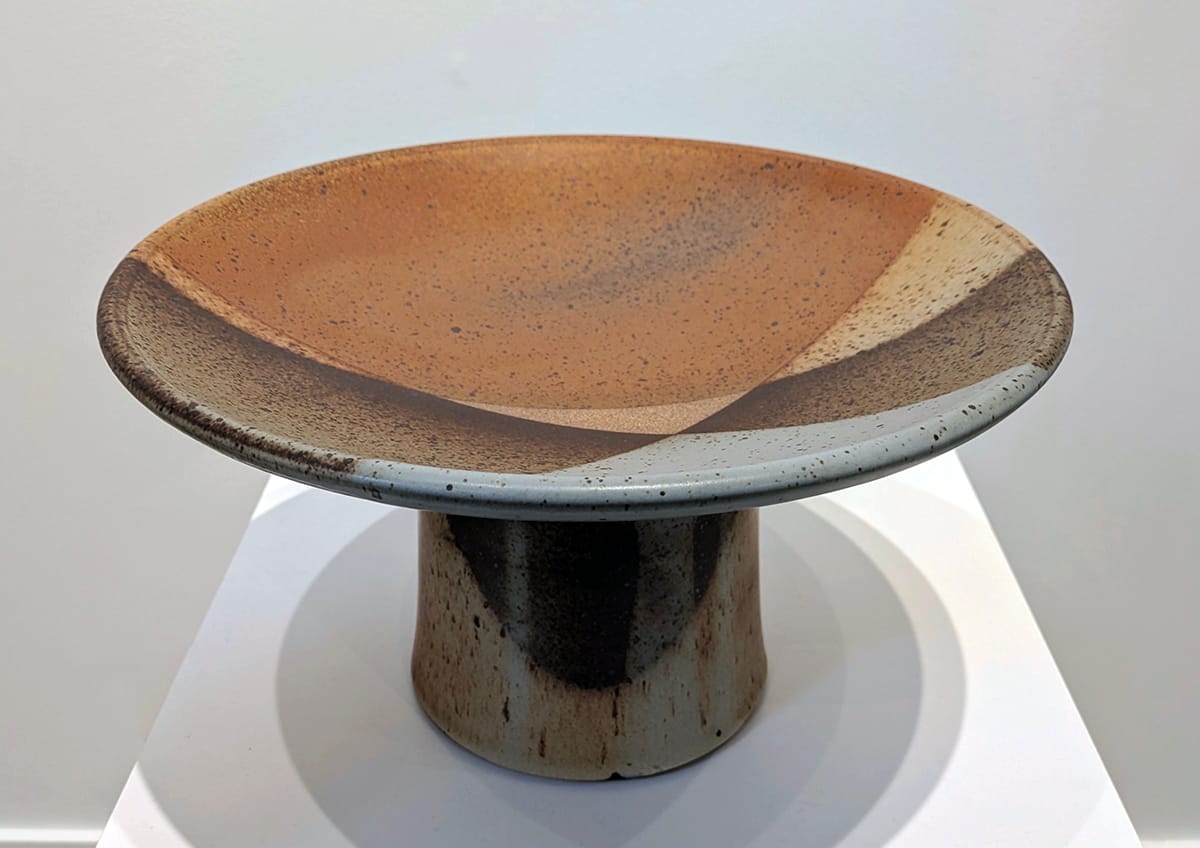
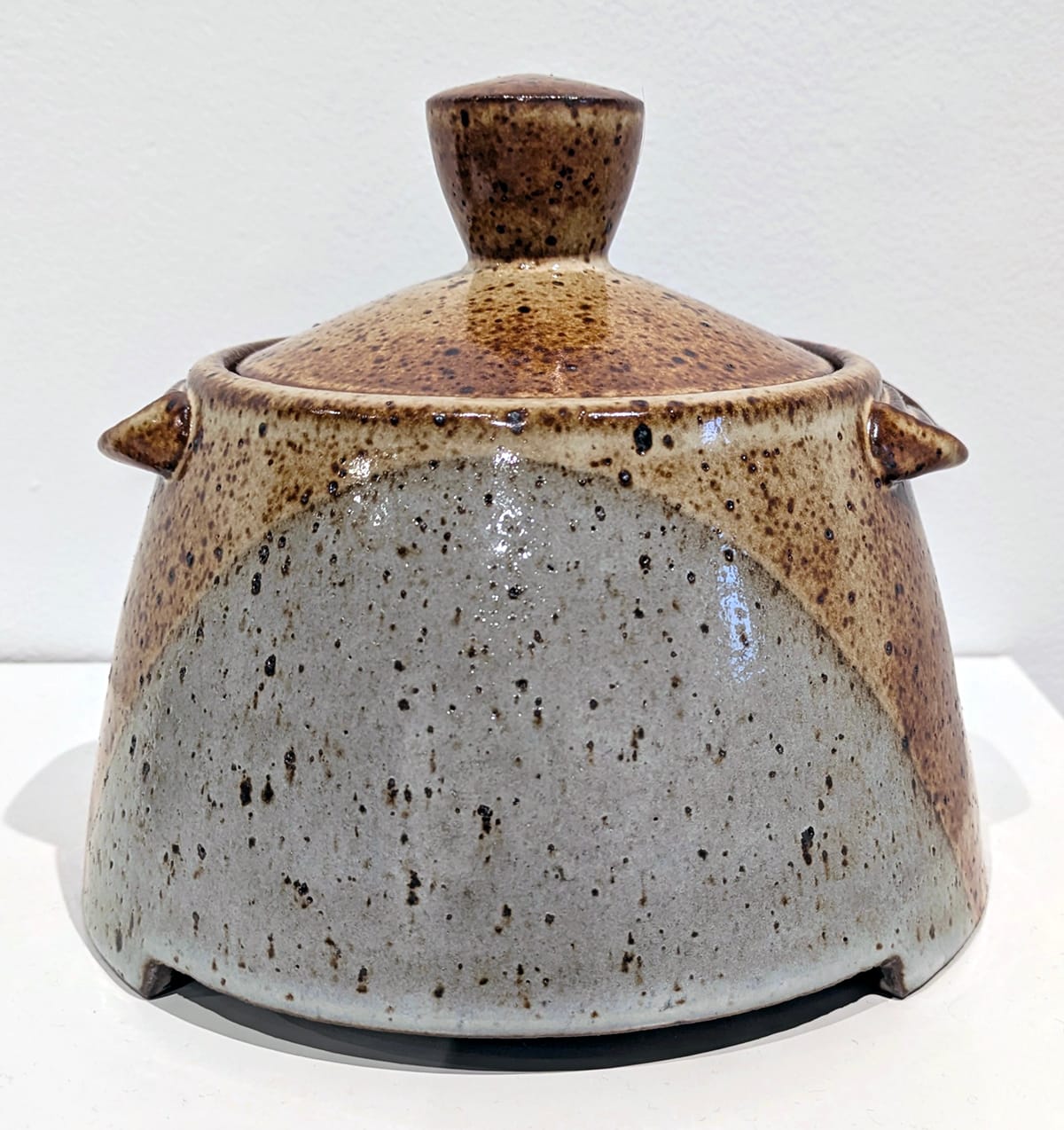
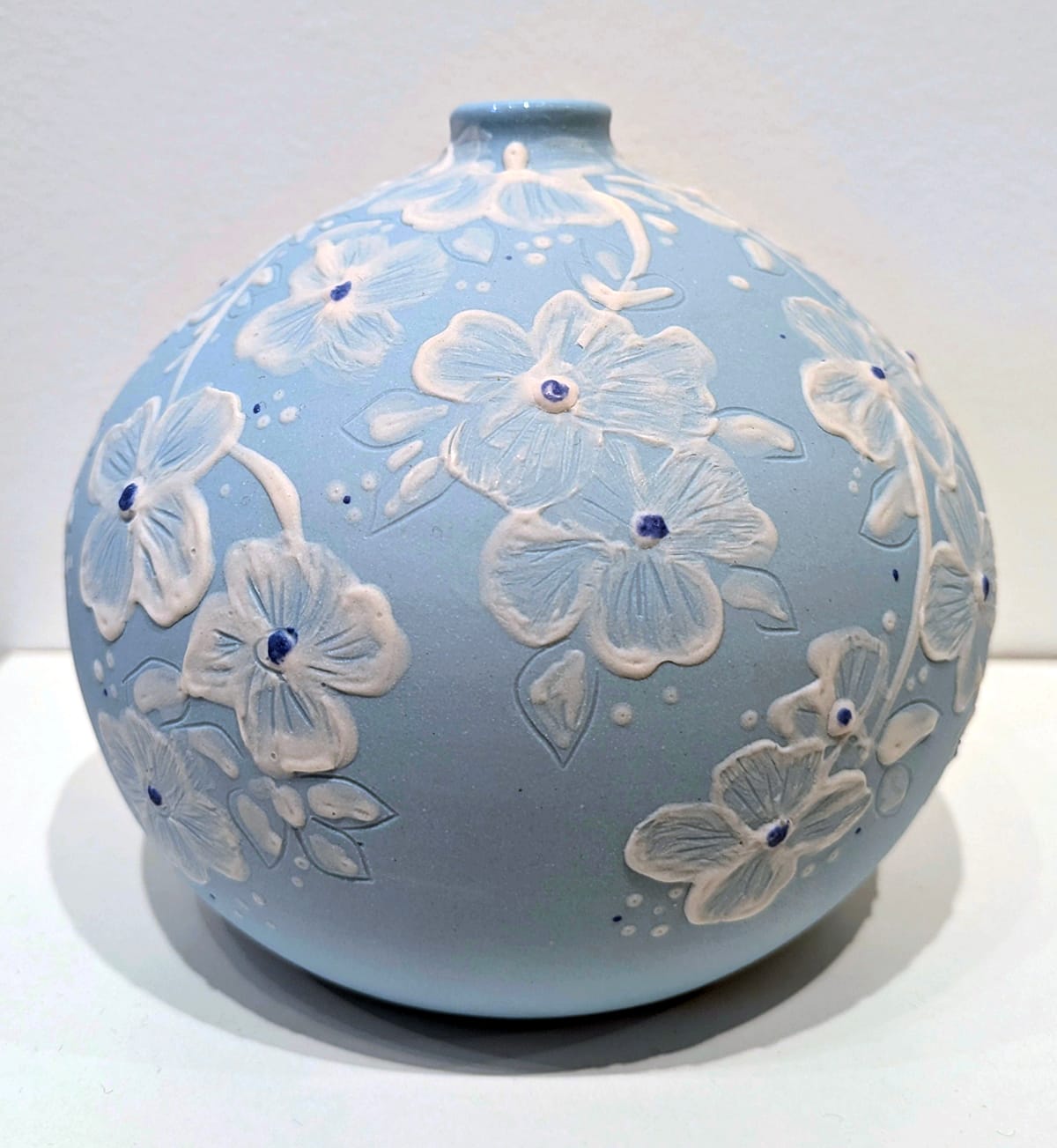
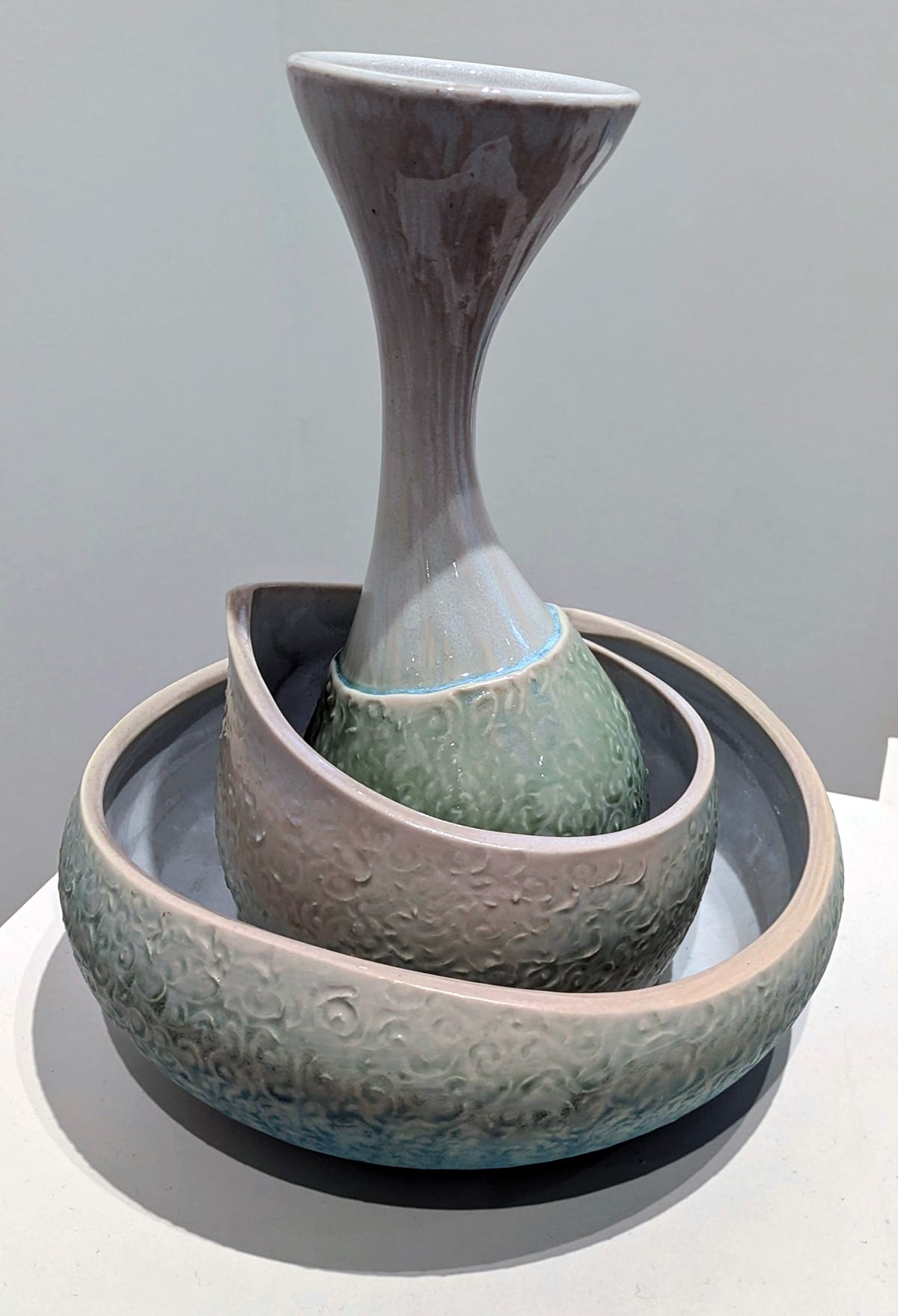
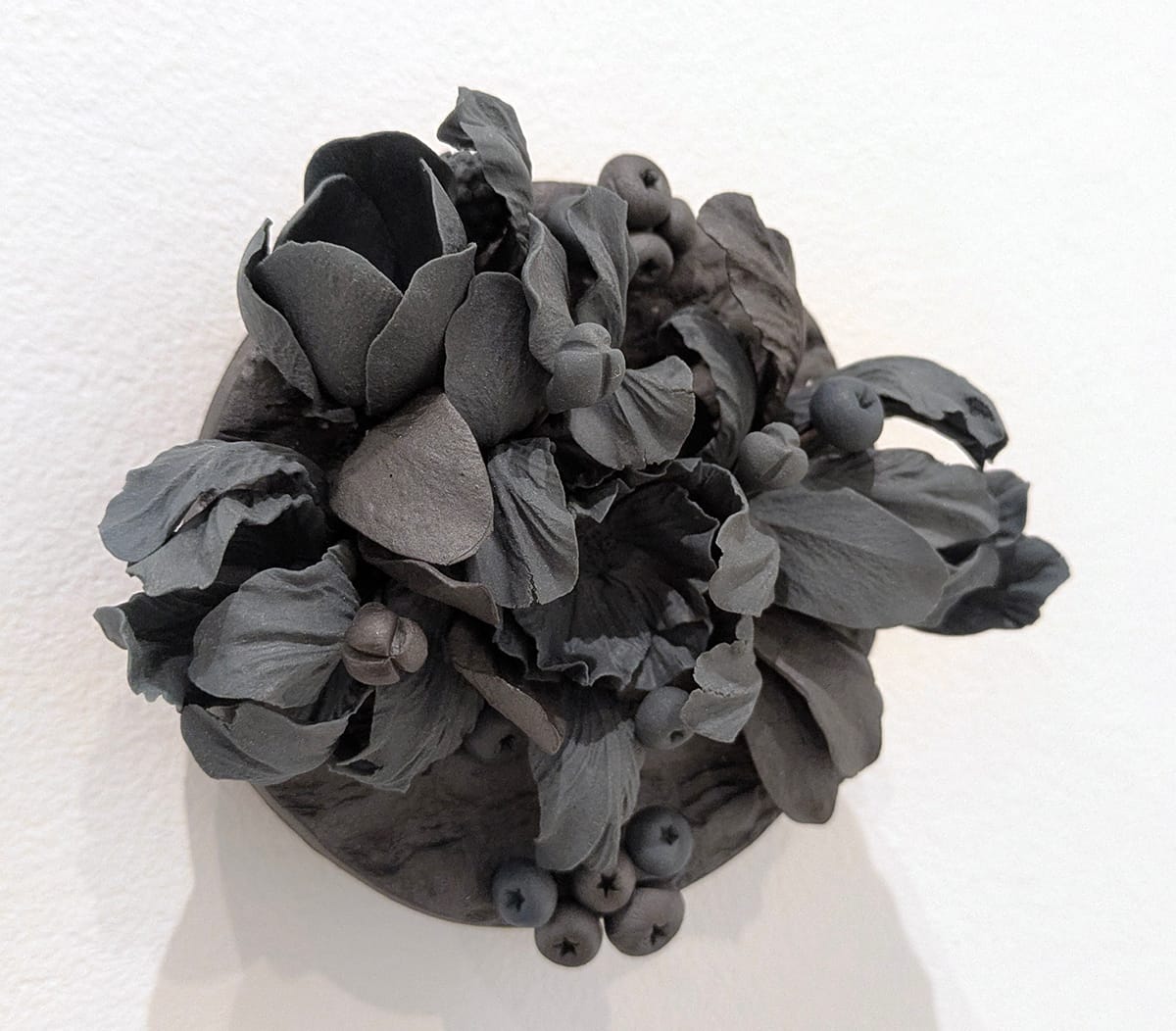
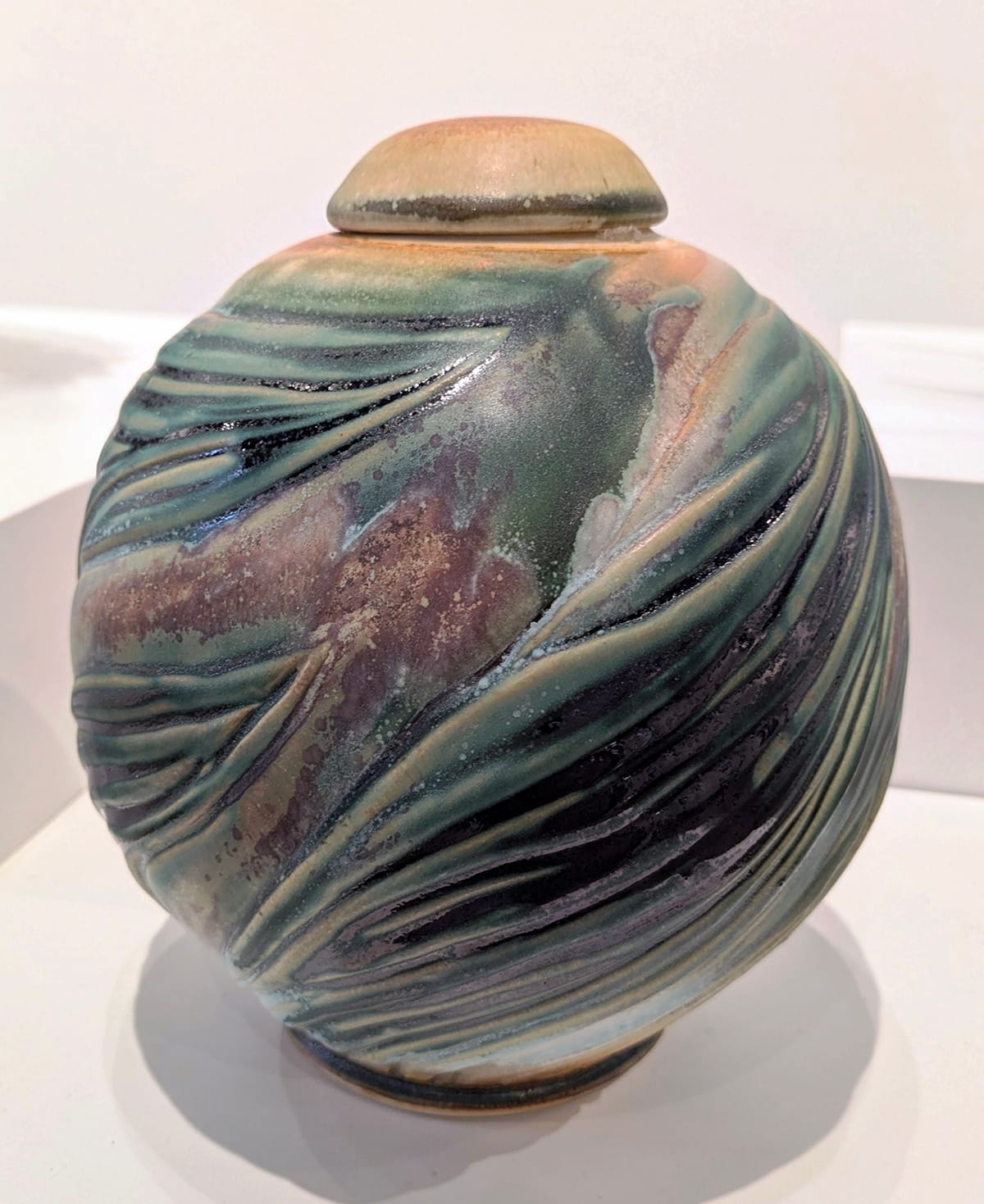
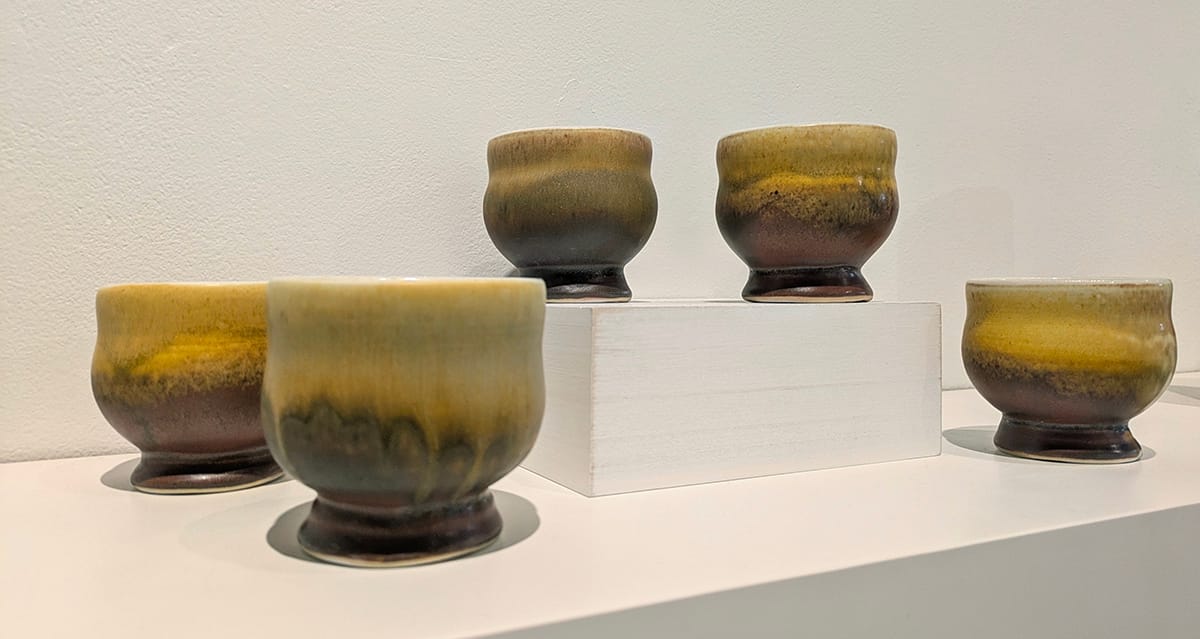
From Left: Allison Achtenhagen, “Pierced Jar,” Ceramic, 9 by 8 by 8 inches; Troy Becker, “Pedestal Bowl,” High-fire reduction stoneware, 7.5 by 13.5 by 13.5 inches; Troy Becker, “Tapered Lidded Form,” High-fire reduction stoneware, 6 by 7 by 7 inches; Kim Brook, “Dogwoods Against a Blue Sky,” Porcelain, slip, glaze, 6 by 6 by 6 inches; Nicole Copel, “Trust,” Porcelain, 12 by 8 by 8 inches; Rain Harris, “Green & Black Floral Wall Tile,” Black clay, colored porcelain, wood, 4 by 4 by 3 inches; Phyll Klima, “Spiral Carved Urn,” Ceramic, glaze, cone 6, 13.5 by 7.5 by 7.5 inches; Monette Mark, “Swallow Set,” Soda-fired porcelain, 3 by 3 by 3 inches. Photos by Jessy Clonts Day for The SHOUT.
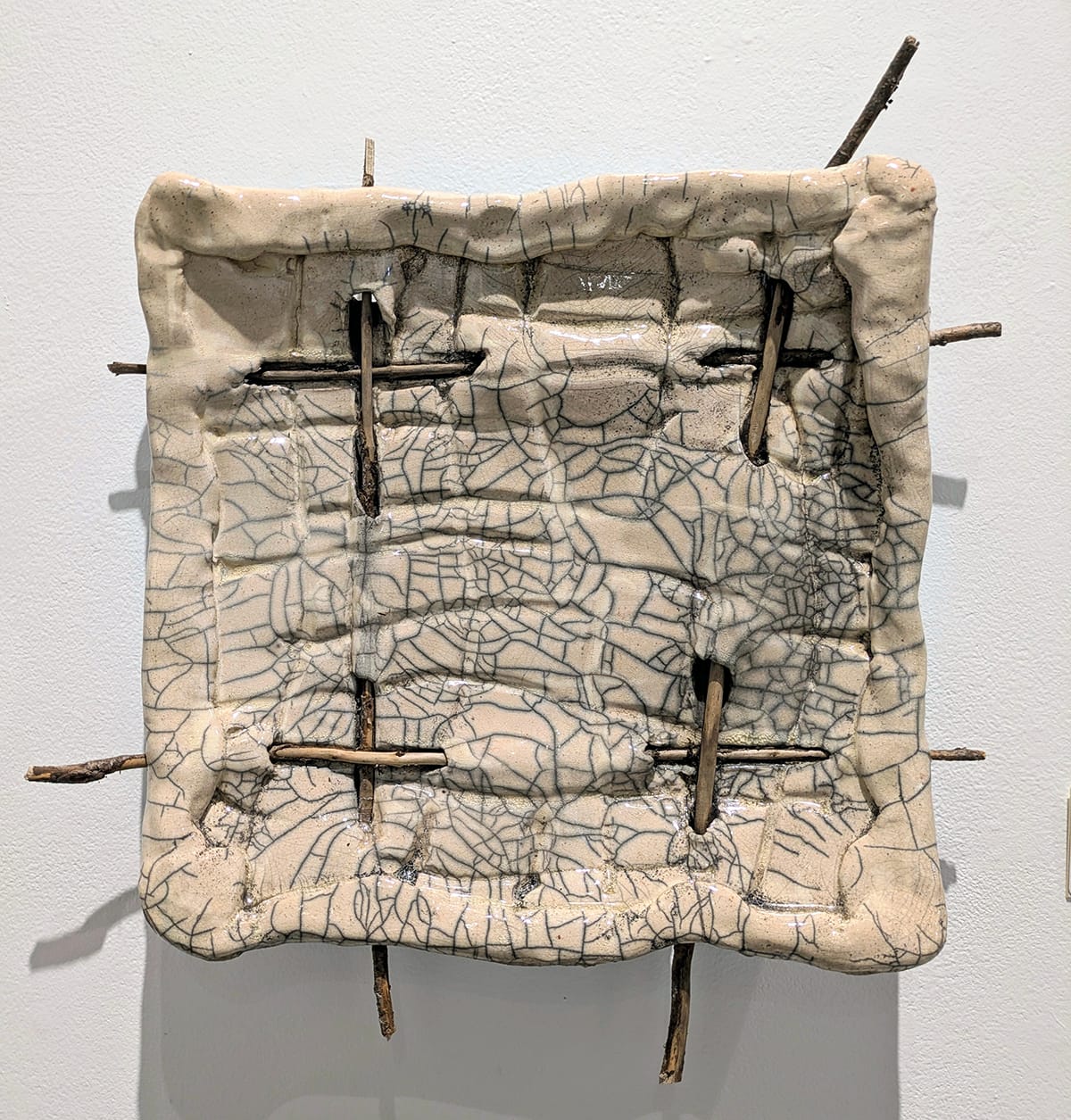
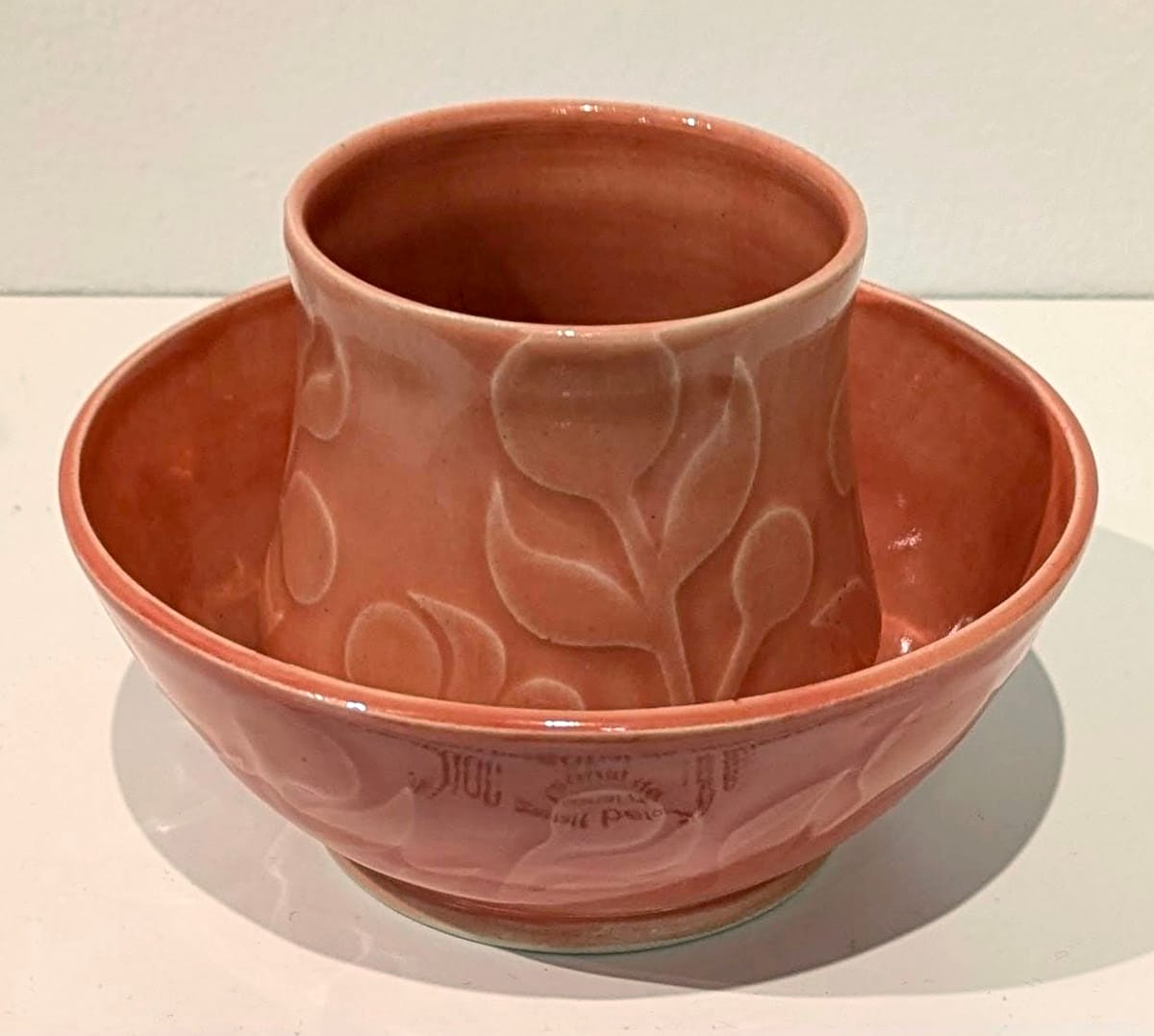
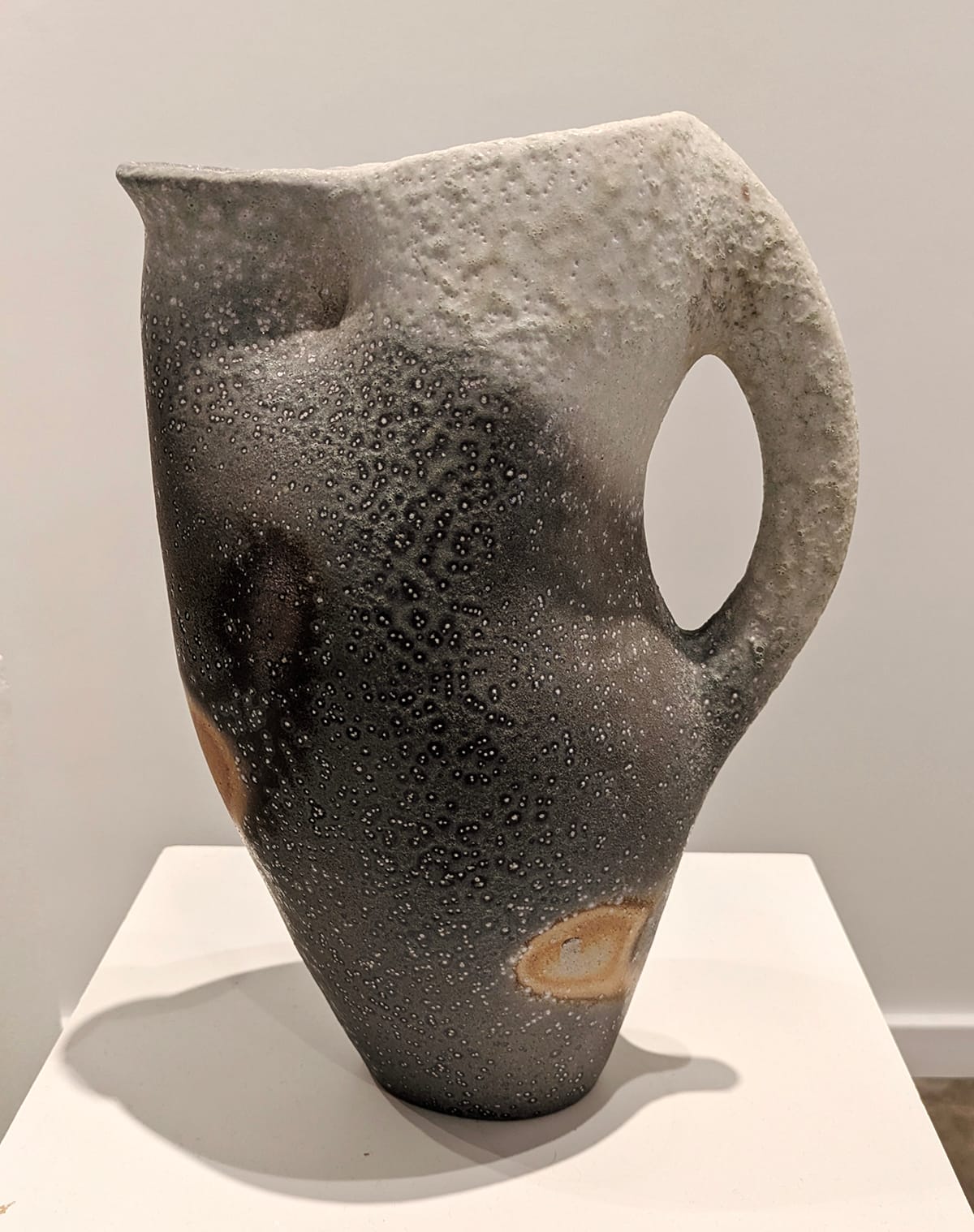
From left: David Mai, “Intersections,” Raku clay, glaze, branches, 17 by 17 by 3 inches; Edel Miller, “Water Etched Cup & Bowl Set,” Ceramic, glaze; Jason Wang, “Grey and Blue Pitcher 3,” white stoneware, glaze, 12 by 5 by 8 inches. Photos by Jessy Clonts Day for The SHOUT.
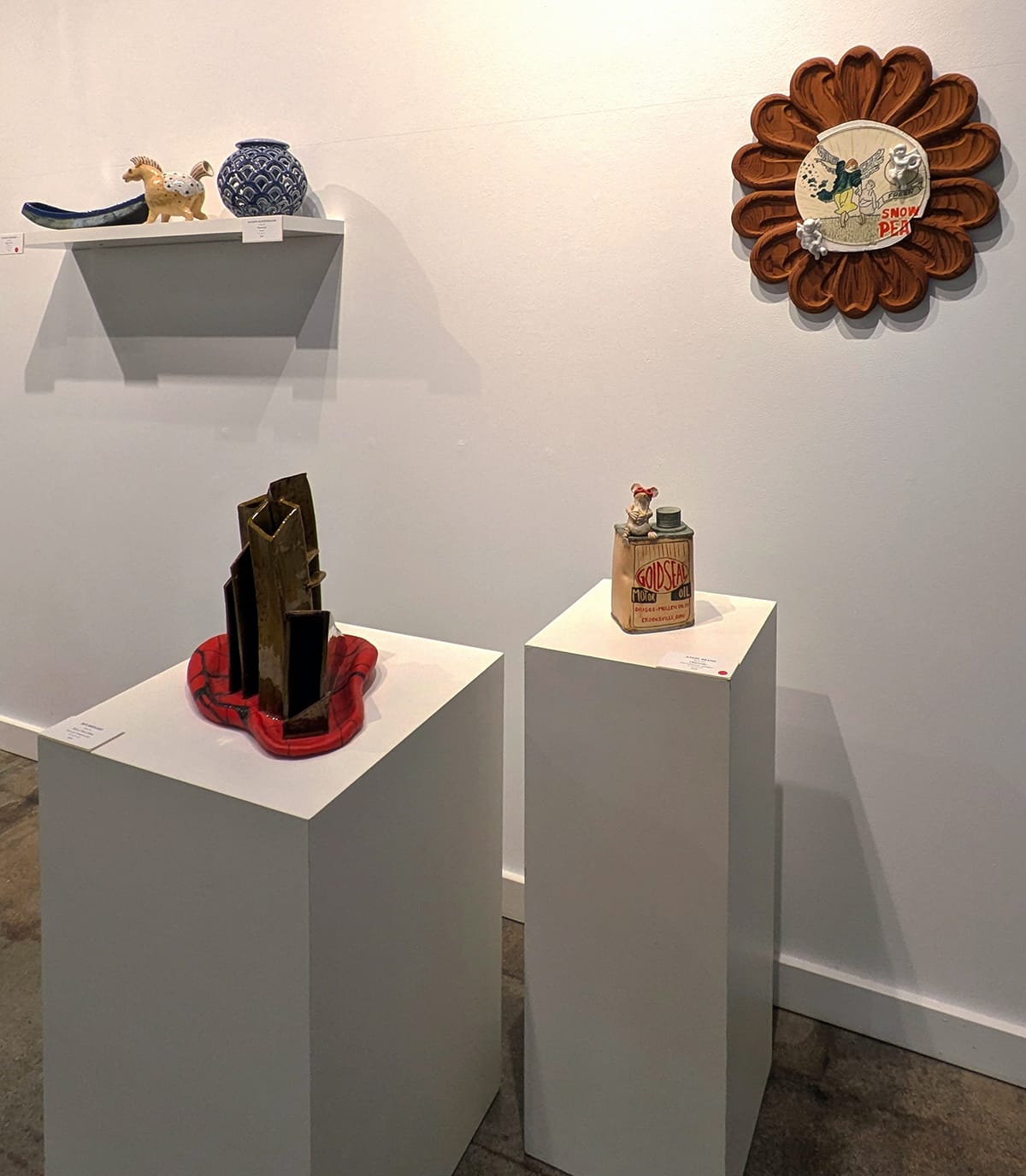
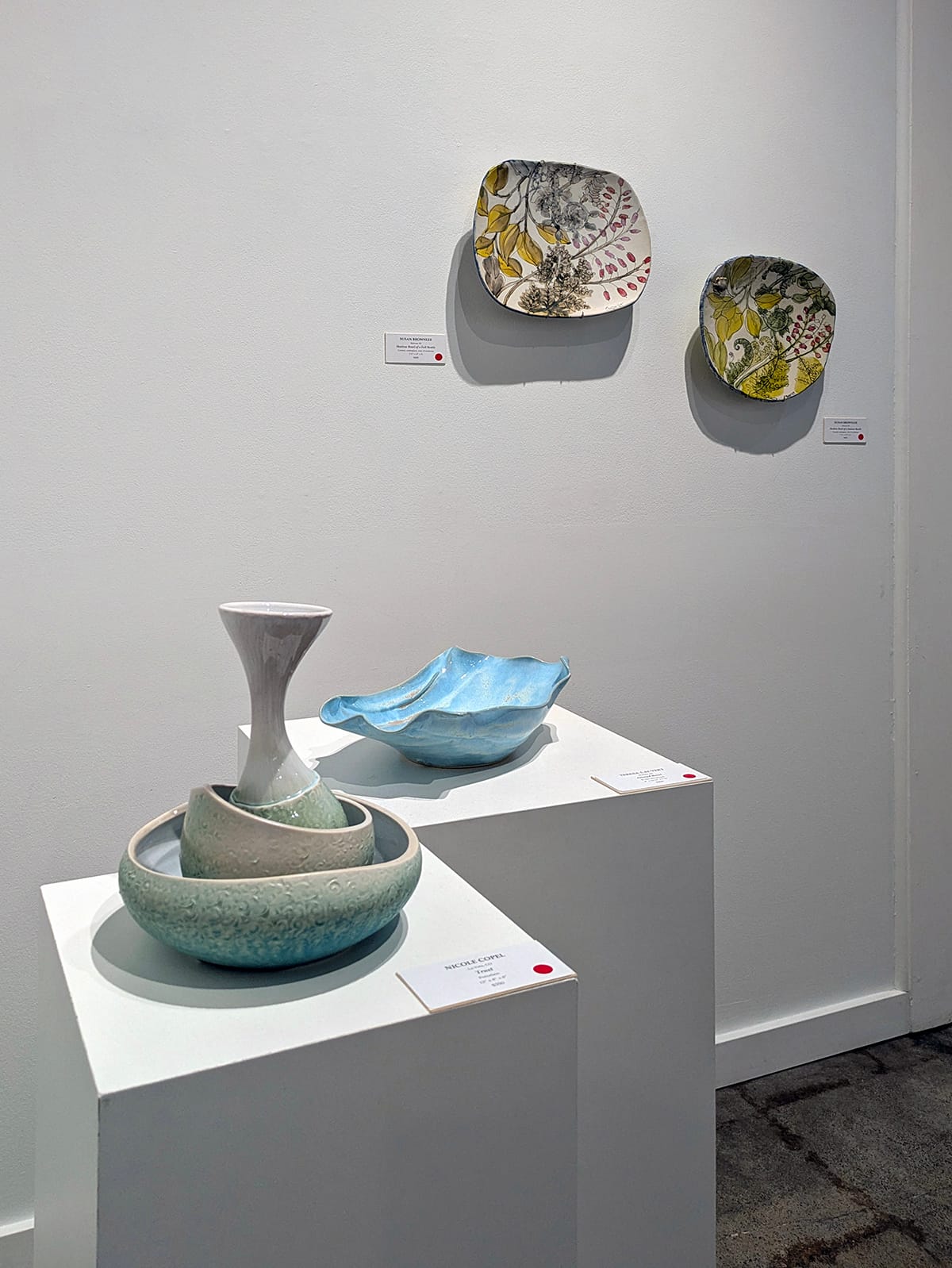
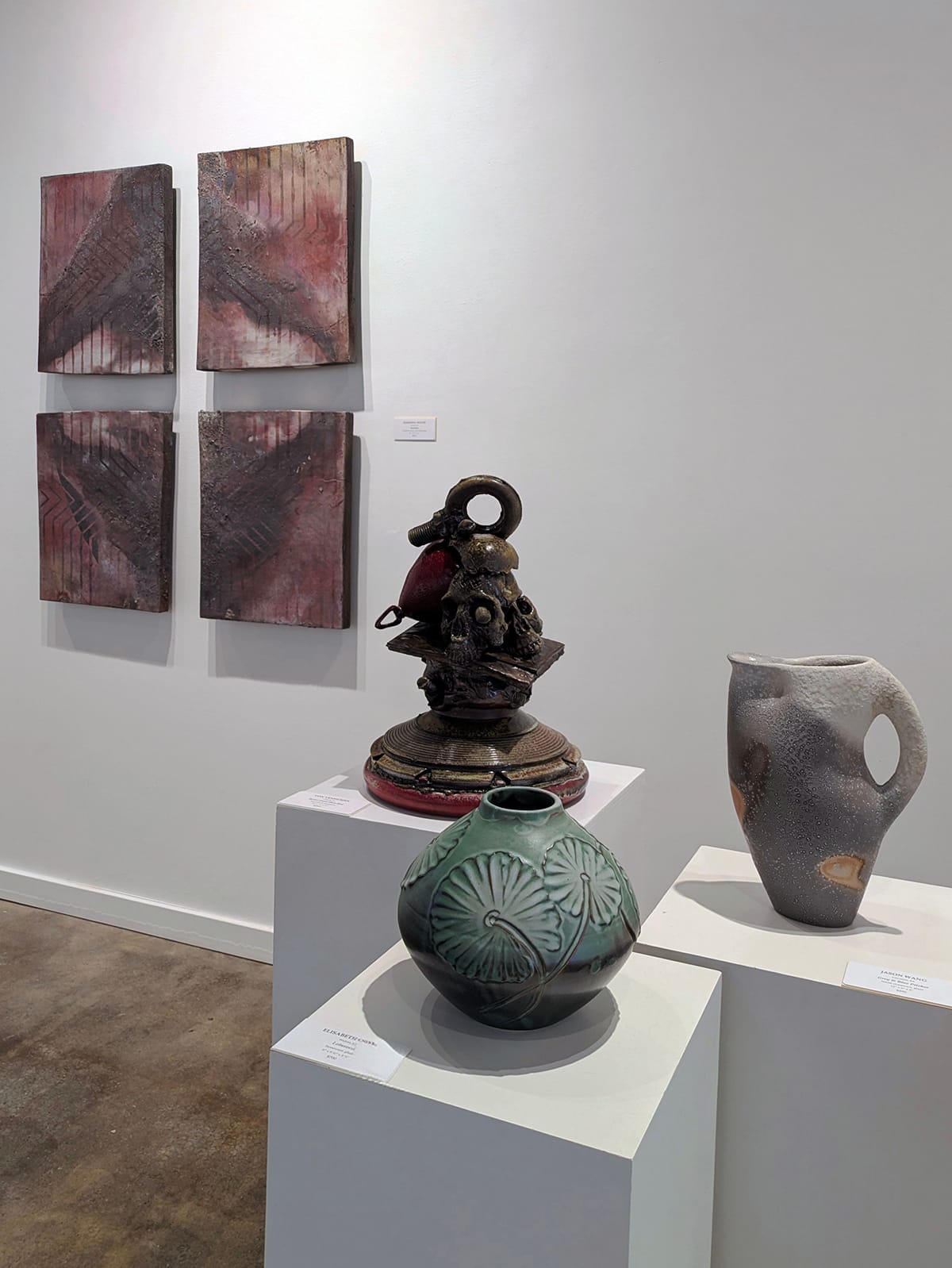
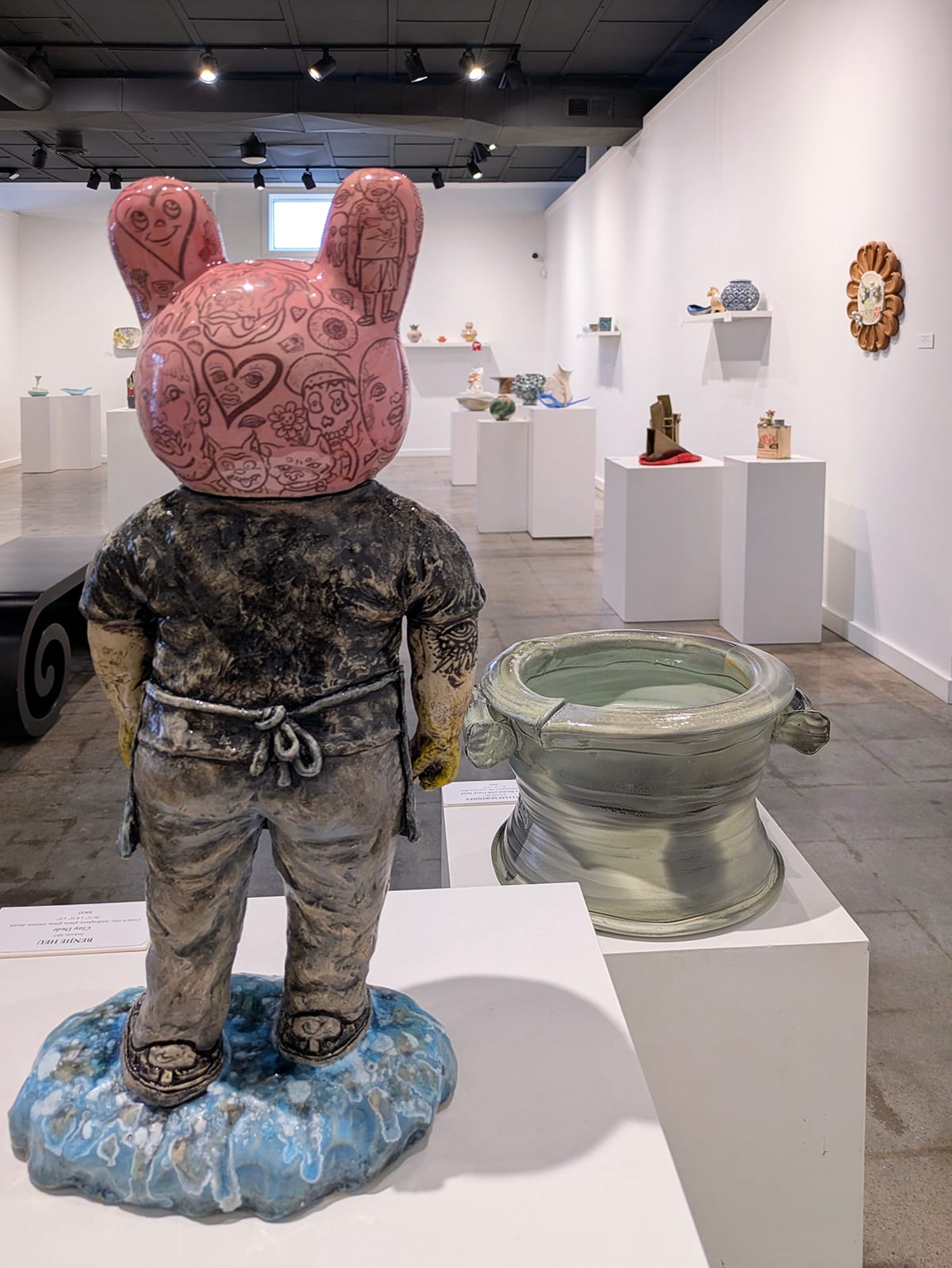
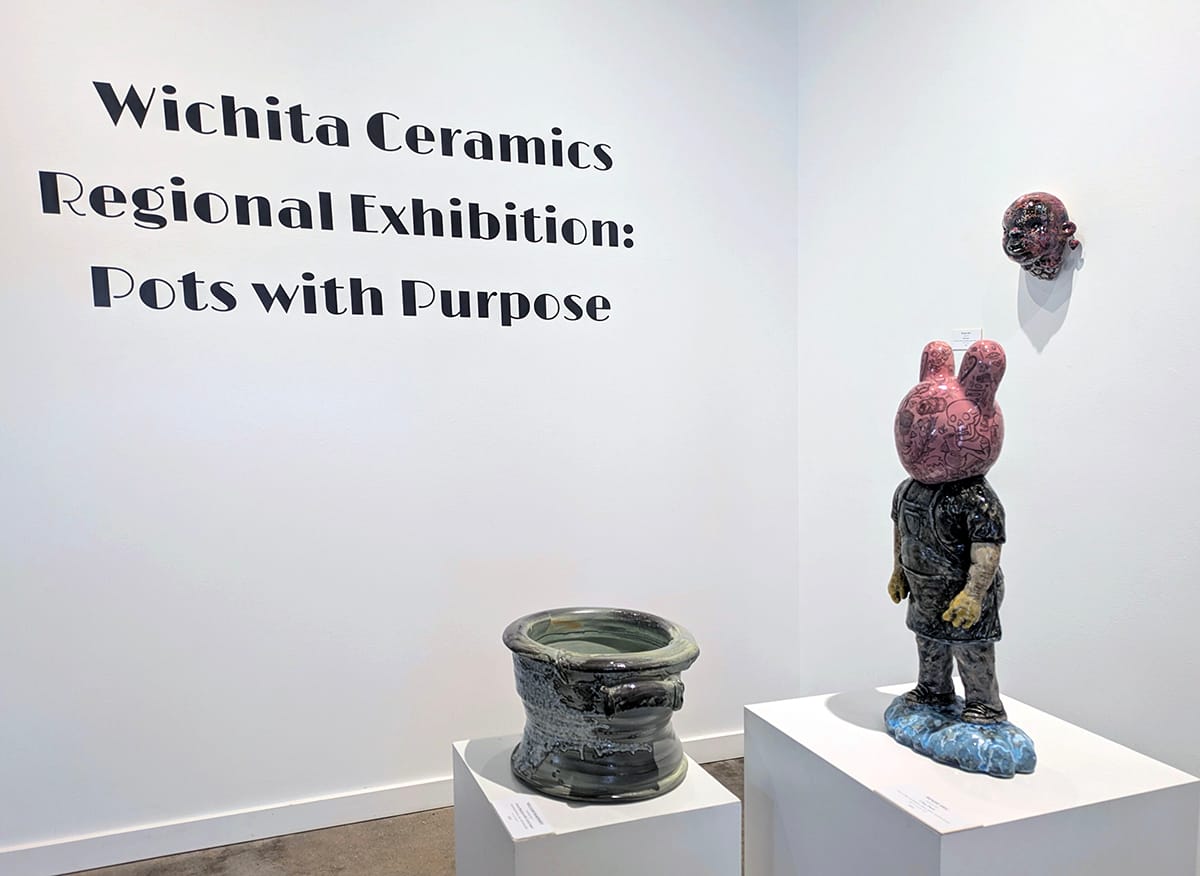
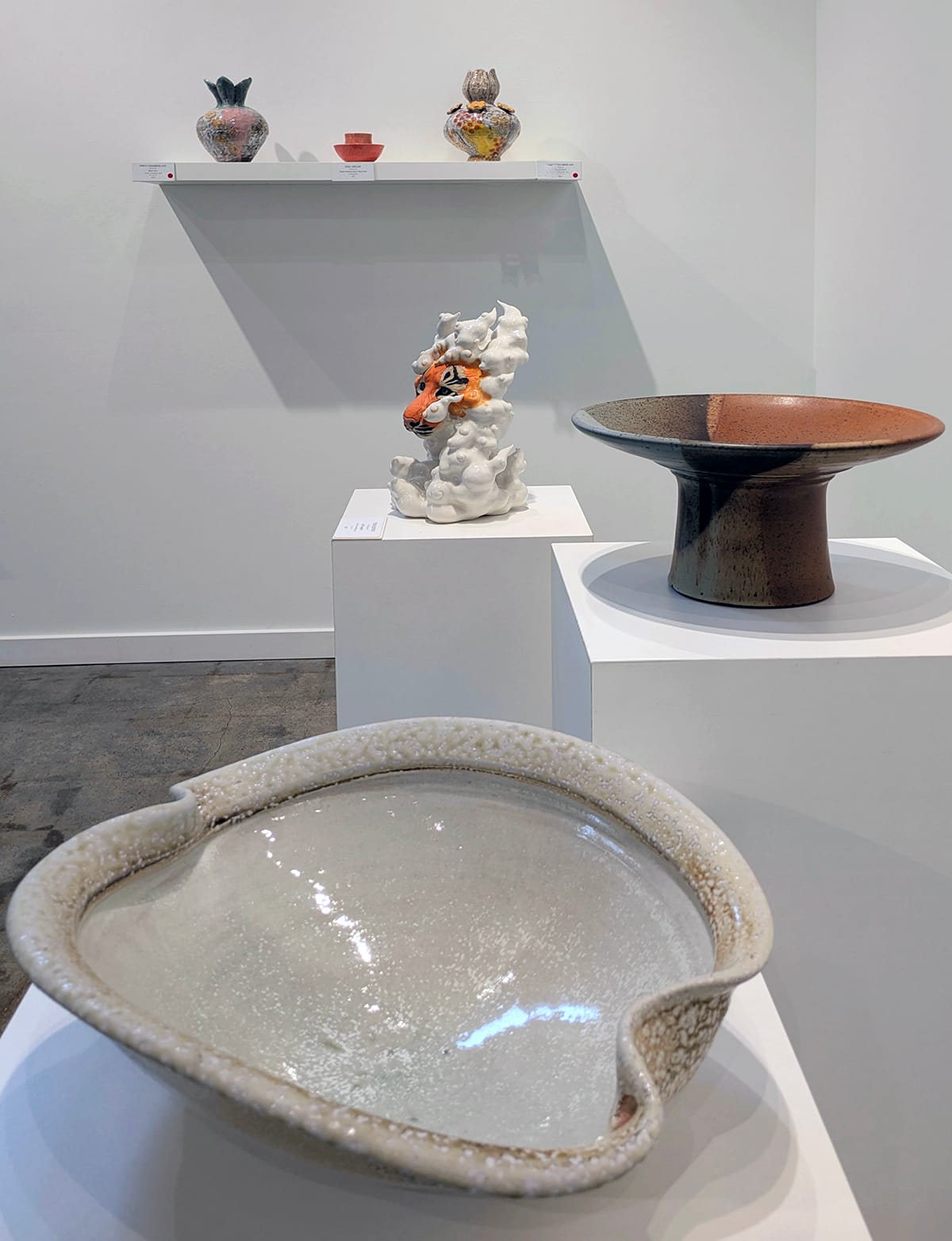
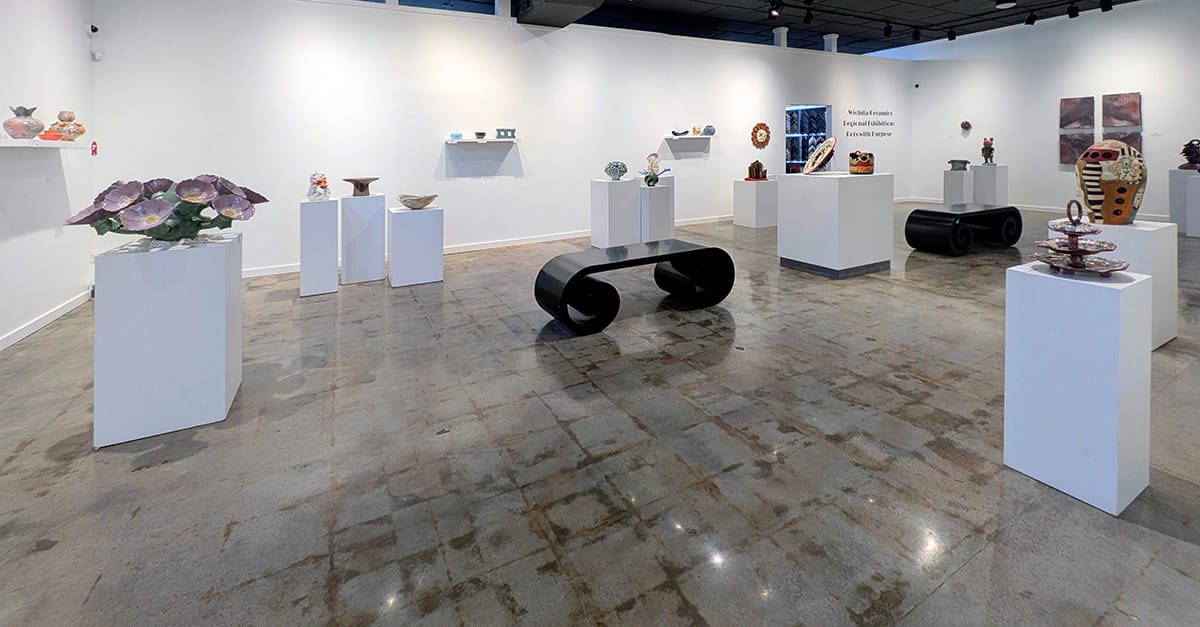
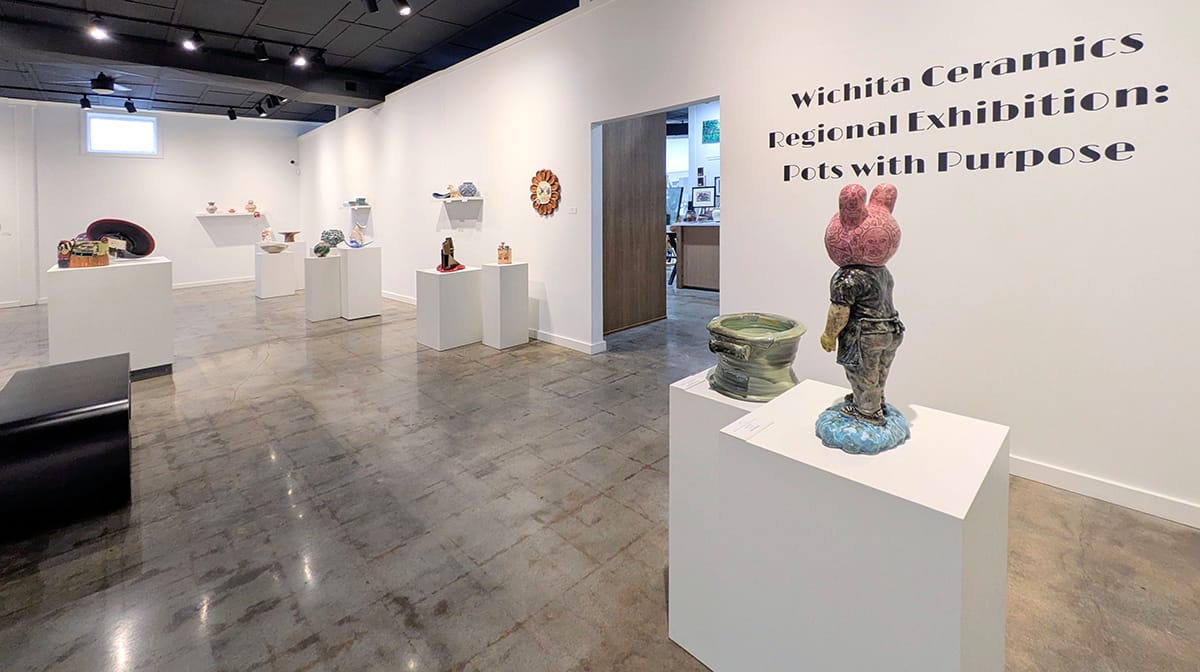
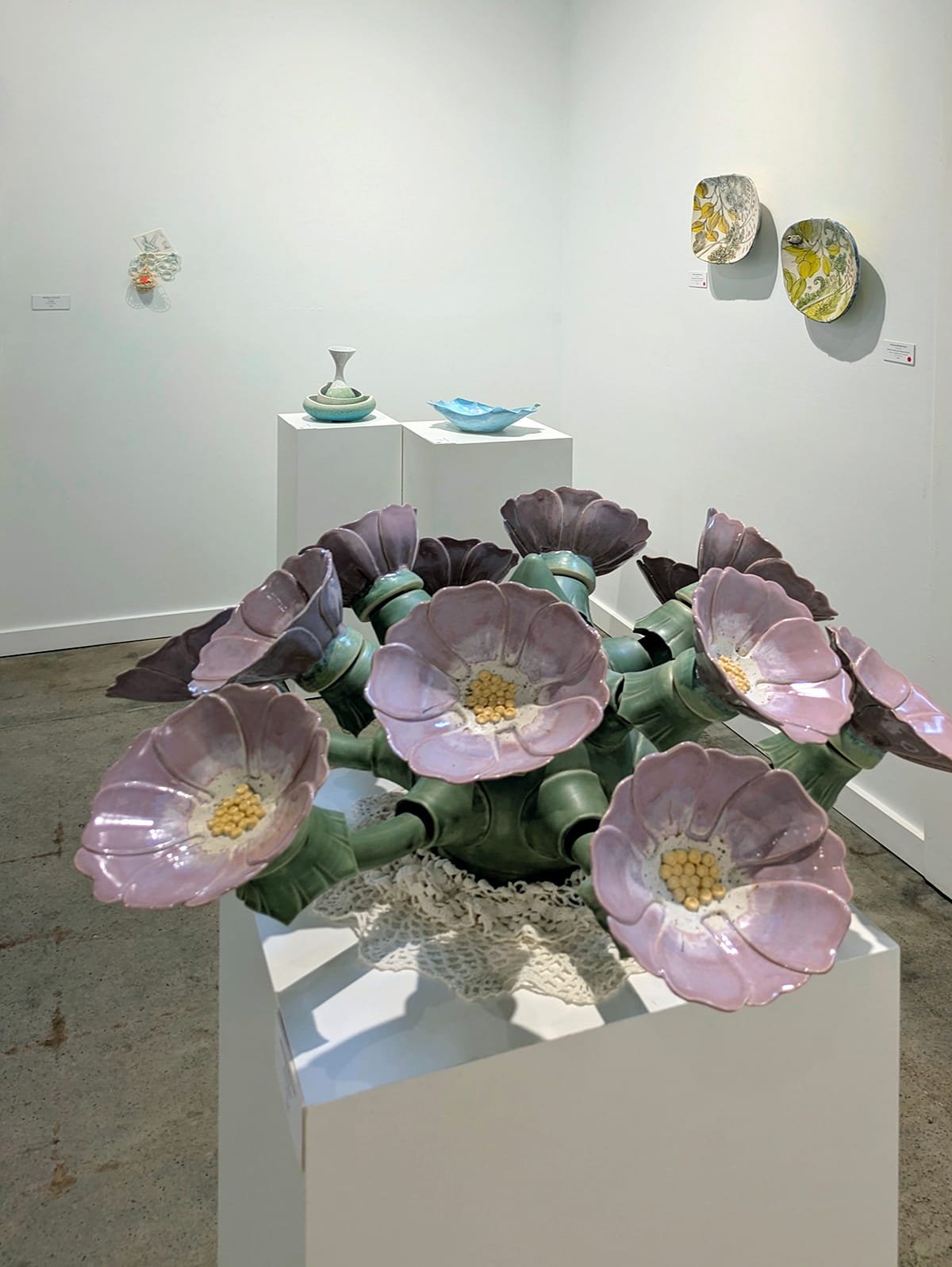
Installation views of “Wichita Ceramics Regional Exhibition: Pots with Purpose” at Reuben Saunders Gallery. Photos by Jessy Clonts Day for The SHOUT.
Correction: This post was updated on October 25 to reflect that there were about 65 applicants who submitted more than 250 entries for this exhibition, instead of more than 250 applicants. Read about our commitment to sharing accurate information.
Jessy Clonts Day is a writer, roller skater, mother, and fourth generation Kansan. After living ten years in the American South and Southwest, she and her spouse returned to Kansas to raise their family, where the sunsets are otherworldly and the arts community is alive and well.
❋ Derby man has the kind of voice that turns heads — and chairs
❋ Socializing while sober: how some Wichitans are cultivating alcohol-free communities
❋ As a small creative business closes, the owner mourns
❋ Painting through it: Autumn Noire on 20 years of making art
❋ How a guy from Wichita resurrected 'Dawn of the Dead'
❋ Bygone Friends University museum housed curious collections
Support Kansas arts writing
The SHOUT is a Wichita-based independent newsroom focused on artists living and working in Kansas. We're partly supported by the generosity of our readers, and every dollar we receive goes directly into the pocket of a contributing writer, editor, or photographer. Click here to support our work with a tax-deductible donation.

